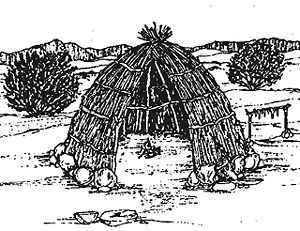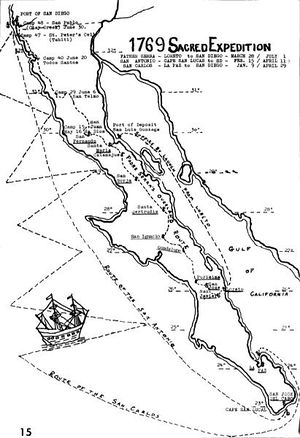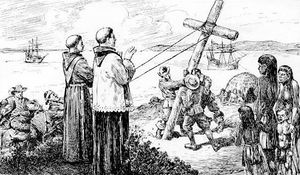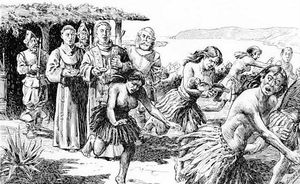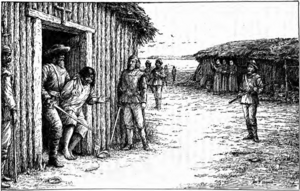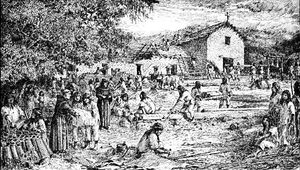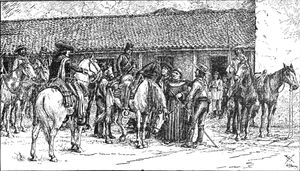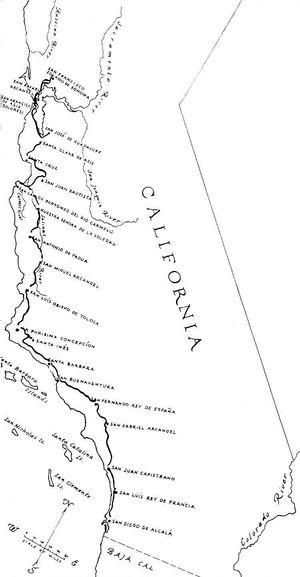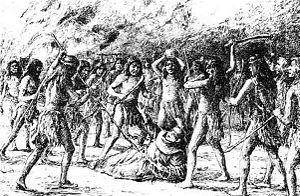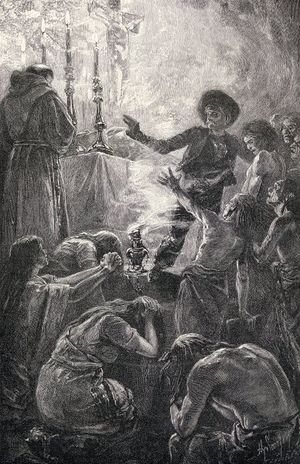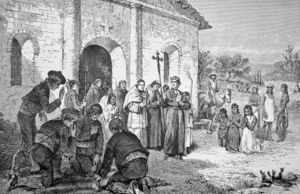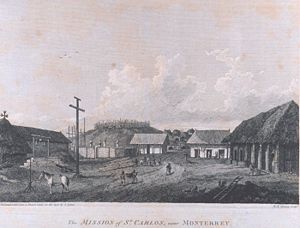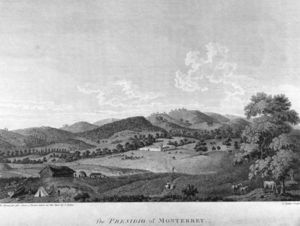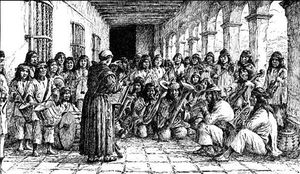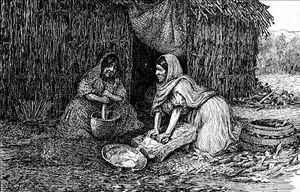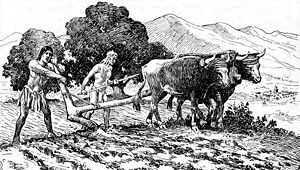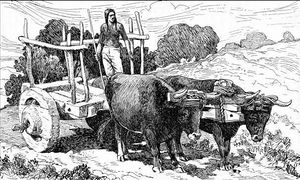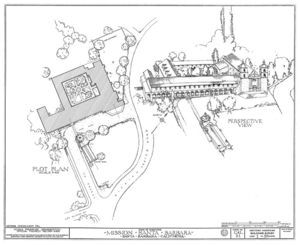Spanish missions in California: Difference between revisions
imported>Robert A. Estremo m (→Mission life: change image order) |
mNo edit summary |
||
| (46 intermediate revisions by 5 users not shown) | |||
| Line 1: | Line 1: | ||
{{Subpages}} | {{Subpages}} | ||
{| border="1" align="right" cellpadding="2" cellspacing="0" width="300" style="margin: 0 0 1em 0.5em" | {| border="1" align="right" cellpadding="2" cellspacing="0" width="300" style="margin: 0 0 1em 0.5em" | ||
|align="center" colspan="2"|[[Image:Reino de la Nueva España a principios del Siglo XIX.jpg|350px]] <small>A map depicting New Spain around the turn of the 19th century. The California missions were situated within, and exerted influence over, the area identified in the upper left as "''Nueva California''," or "New" California.<ref>{{Reino de la Nueva España a principios del Siglo XIX.jpg/credit}}</ref><ref name="saunders65">Saunders and Chase, p. 65</ref></small> | |align="center" colspan="2"|[[Image:Reino de la Nueva España a principios del Siglo XIX.jpg|350px]] <small>A map depicting New Spain around the turn of the 19th century. The California missions were situated within, and exerted influence over, the area identified in the upper left as "''Nueva California''," or "New" California.<ref>{{Reino de la Nueva España a principios del Siglo XIX.jpg/credit}}</ref><ref name="saunders65">Saunders and Chase, p. 65</ref></small> | ||
| Line 9: | Line 8: | ||
|- | |- | ||
|<small>[[Mission San Carlos Borromeo de Carmelo]], founded in 1770 | |<small>[[Mission San Carlos Borromeo de Carmelo]], founded in 1770 | ||
|- | |-o | ||
|<small>[[Mission San Antonio de Padua]], founded in 1771 | |<small>[[Mission San Antonio de Padua]], founded in 1771 | ||
|- | |- | ||
| Line 49: | Line 48: | ||
|} | |} | ||
<!-- need to rewrite to better summarize the article -->The '''Spanish missions in California''' | <!-- need to rewrite to better summarize the article -->The '''Spanish missions in California''' consisted of twenty-one religious outposts (along with their associated dependencies) established by [[Spain|Spaniards]] of the Franciscan Order between 1769 and 1823. The mission outposts were situated along a 600-mile trail dubbed ''El Camino Real'', or "The Royal Highway." Considered by the [[Spain|Spanish Empire]] to be the only viable method of spreading the [[Catholic]] faith among the local Native American populations, the missions represented the first major effort by [[Europe]]ans to colonize the Pacific Coast region, and helped Spain enforce its 167-year-old claim to Alta California as established by Sebastián Vizcaíno in 1602. By the time that Spanish occupation efforts began in earnest in the late 1760s there were hundreds of tribes inhabiting the region, each with its own diverse culture and language. The settlers introduced European livestock, fruits, vegetables, and industry into the region. European contact was a momentous event, which profoundly affected California's native peoples. Ultimately, the mission system failed in its objective to convert, educate, and "civilize" the indigenous population in order to transform the [[California (U.S. state)|California]] natives into Spanish colonial citizens, and therefore did not provide the anticipated economic benefits as well. <!-- need to better develop this thought train; architecture, literature, other -->The missions' unique design cues had a lasting influence on California architecture. A combination of natural disasters and neglect caused most of the mission structures to fall into ruin, though nearly all have since been rebuilt or restored. The ownership of all but two of the missions was returned to the Catholic Church via Presidential proclamations; Mission La Purísima Concepción and Mission San Francisco Solano are administered by the California Department of Parks and Recreation as State Historic Parks. Today, the missions are among the state's oldest structures and the most-visited historic monuments. | ||
==History== | ==History== | ||
| Line 59: | Line 58: | ||
===Early exploration and contact=== | ===Early exploration and contact=== | ||
By the time of the earliest European contacts, California was the most densely populated area north of Mexico.<ref>Paddison, p. x</ref> Beginning in 1492 with the voyages of [[Christopher Columbus]], the Kingdom of Spain sought to establish missions to convert the pagans in ''Nueva España'' (" | By the time of the earliest European contacts, California was the most densely populated area north of Mexico.<ref>Paddison, p. x</ref> Beginning in 1492 with the voyages of [[Christopher Columbus]], the Kingdom of Spain sought to establish missions to convert the pagans in ''Nueva España'' ("New Spain," consisting of the [[Caribbean]], [[Mexico]] and most of what today is the Southwestern United States) to Roman Catholicism, in order to facilitate colonization of these lands awarded to Spain by the Catholic Church, including that region known as [[California (U.S. state)|Alta California]].<ref>The Spanish claim to the Pacific Northwest had dated back to a 1493 papal bull (''Inter caetera'') issued by Pope Alexander VI and rights contained in the 1494 Treaty of Tordesillas; these two formal acts gave Spain the exclusive rights to colonize all of the Western Hemisphere (save for Brazil), including the west coast of North America.</ref><ref>The term "Alta California" as applies to the mission chain founded by Serra refers specifically to the modern-day U.S. State of California.</ref><ref>Paddison, p. xii: Despite Vizcaíno's recommendations, the Spanish government felt that Alta California was too distant to effectively colonize, and at the same time too close to Mexico to warrant the establishment of a port at San Diego; a royal order prohibiting further exploration of the region was issued in 1606.</ref><ref>Leffingwell, p. 10: Father [[Antonio de la Ascensión]], a Carmelite priest who visited San Diego with Vizcaíno's 1602 expedition, "''surveyed the area and concluded that the land was fertile, the fish plentiful, and gold abundant''." Ascensión was convinced that California's potential wealth and strategic location merited colonization, and in 1620 recommended in a letter to Madrid that missions be established in the region, a venture that would involve military as well as religious personnel.</ref> However, it was not until 1741—the time of the Vitus Bering expedition, when the territorial ambitions of Tsarist Russia towards North America became known—that King Philip V felt such installations were necessary in Upper California.<ref>Morrison, p. 214: During his voyage of exploration along the Pacific Coast of North America in 1579, Sir Francis Drake claimed the region (which he dubbed ''Nova Albion'', Latin for "New Britain") in the name of [[England]], a full generation before the first landing in Jamestown, Virginia. In order to preserve an uneasy peace with Spain, and to avoid having Spain threaten England's claims in the New World, both the discovery of and claim on New Albion was ordered by Queen Elizabeth I to be treated as a state secret.</ref><ref>Chapman, p. 216: "''It is usually stated that the Spanish court at Madrid received reports about Russian aggressions in the Pacific northwest, and sent orders to meet them by the occupation of Alta California, wherefore the expeditions of 1769 were made. This view contains only a smattering of the truth. It is evident from [José de] Gálvez's correspondence of 1768 that he and [Carlos Francisco de] Croix had discussed the advisability of an immediate expedition to Monterey, long before any word came from Spain about the Russian activities''."</ref><ref>Bennett 1897a, pp. 11-12: California had been visited a number of times since Juan Rodríguez Cabrillo’s discovery in 1542, which initially included notable expeditions led by Englishmen Francis Drake in 1579 and Thomas Cavendish 1587, and later on by Woodes Rogers (1710), George Shelvocke (1719), James Cook (1778), and finally George Vancouver in 1792. Spanish explorer Sebastián Vizcaíno made landfall in San Diego Bay in 1602, and the famed ''[[conquistador]]'' Hernán Cortés explored the California Gulf Coast in 1735.</ref> California represents the "high-water mark" of Spanish expansion in North America, it being the last and northernmost colony on the continent.<ref>Rawls, p. 3</ref> The mission system arose in part from the need to control Spain's ever-expanding holdings in the New World. Realizing that the colonies would require a literate population base that the mother country could not supply, the government (with the cooperation of the Church) established a network of missions with the goal of converting the natives to Christianity; the aim was to make converts and tax paying citizens of the indigenous peoples they conquered.<ref>Bennett 1897a, p. 10: "''Other pioneers have blazed the way for civilization by the torch and the bullet, and the red man has disappeared before them; but it remained for the Spanish priests to undertake to preserve the Indian and seek to make his existence compatible with a higher civilization''."</ref> In order to become Spanish citizens and productive inhabitants, the native Americans were required to learn Spanish language and vocational skills along with Christian teachings.<ref>"Old Mission Santa Inés:" Per clerical historian [[Maynard Geiger]], "''This was to be a cooperative effort, imperial in origin, protective in purpose, but primarily spiritual in execution''."</ref> Estimates for the precontact native population in California have been based on a number of different sources (and therefore vary substantially), but indigenous peoples may have numbered as high as 300,000, divided into more than 100 separate tribes or nations.<ref>Rawls, p. 6</ref><ref>Kroeber 1925, p. vi.: "''In the matter of population, too, the effect of Caucasian contact cannot be wholly slighted, since all statistics date from a late period. The disintegration of native numbers and native culture have proceeded hand in hand, but in very different rations according to locality. The determination of population strength before the arrival of whites is, on the other hand, of considerable significance toward the understanding of Indian culture, on account of the close relations which are manifest between type of culture and density of population''."</ref><ref>Chapman, p. 383: "''...there may have been about 133,000 [native inhabitants] in what is now the state as a whole, and 70,000 in or near the conquered area. The missions included only the Indians of given localities, though it is true that they were situated on the best lands and in the most populous centers. Even in the vicinity of the missions, there were some unconverted groups, however''." </ref> | ||
On January 29, 1767 King Charles III ordered the Jesuits, who had established a chain of fifteen missions throughout | On January 29, 1767 King Charles III ordered the Jesuits, who had established a [[Spanish missions in Baja California|chain of fifteen missions throughout Baja California]], forcibly expelled and returned to the home country.<ref>Bennett 1897a, p. 15: Due to the isolation of the Baja California missions, the decree for expulsion did not arrive in June of 1767, as it did in the rest of New Spain, but was delayed until the new governor, Portolà, arrived with the news on November 30. Jesuits from the operating missions gathered in Loreto, whereupon they left for exile on February 3, 1768.</ref> ''Visitador General'' José de Gálvez engaged the Franciscans, under the leadership of Fray Junípero Serra, to take charge of those outposts on March 12, 1768.<ref>Bennett 1897a, p. 16</ref> The ''padres'' closed or consolidated several of the existing settlements, and also founded ''La Misión San Fernando Rey de España de Velicatá'' (the only Franciscan mission in all of Baja California) and the nearby ''Visita de la Presentación'' in 1769. This plan, however, was changed within a few months after Gálvez received the following orders: "''Occupy and fortify San Diego and Monterey for God and the King of Spain.''" <ref>James, p. 11</ref> It was thereupon decided to call upon the priests of the Dominican Order to take charge of the Baja California missions in order to allow the Franciscans to concentrate on founding new missions in Alta California.<ref>Guest: "''The blueprint for Alta California provided for a system of settlements significantly different from those in Baja California and Sonora. In their original design, both presidios and missions were different from their predecessors to the south. The plan to make the presidios agriculturally productive did not succeed. Neither did the plan for the mission-pueblos as racially integrated nuclei of urban centers, but the ideal of a closer association between "missionized" Indians and ''gente de razón'', notwithstanding the opposition of the friars, was partially realized. The Spanish government, in its approach to the problem of colonizing Alta California, did not blindly tread the beaten track of past practices and traditions. Willing to correct the mistakes of the past, prepared to experiment with new ideas, ready to change, to modify, to adjust, the civil and military authorities of New Spain and of Alta California were open-minded, flexible, resourceful, and inventive''."</ref> | ||
===Founding=== | ===Founding=== | ||
| Line 69: | Line 68: | ||
Prior to 1754, grants of mission lands were made directly by the Spanish Crown; however, given the remote locations and the inherent difficulties in communicating with the territorial governments, power was transferred to the viceroys of New Spain to grant lands and establish missions in North America.<ref>Capron, p. 3</ref> The twenty-one Alta California missions were established along the northernmost section of California's ''[[El Camino Real]]'' (Spanish for "The Royal Highway," though often referred to as "The King's Highway", christened in honor of King Charles III of Spain), much of which is now U.S. Route 101 and several Mission Streets. The mission planning was begun in 1767 under the leadership of Fray Junípero Serra, O.F.M. (who, in 1767, along with his fellow priests, had taken control over a group of missions in Baja California previously administered by the Jesuits). | Prior to 1754, grants of mission lands were made directly by the Spanish Crown; however, given the remote locations and the inherent difficulties in communicating with the territorial governments, power was transferred to the viceroys of New Spain to grant lands and establish missions in North America.<ref>Capron, p. 3</ref> The twenty-one Alta California missions were established along the northernmost section of California's ''[[El Camino Real]]'' (Spanish for "The Royal Highway," though often referred to as "The King's Highway", christened in honor of King Charles III of Spain), much of which is now U.S. Route 101 and several Mission Streets. The mission planning was begun in 1767 under the leadership of Fray Junípero Serra, O.F.M. (who, in 1767, along with his fellow priests, had taken control over a group of missions in Baja California previously administered by the Jesuits). | ||
The Franciscans' first campaign into Upper California commenced in January of 1769. Four separate expeditions were undertaken in order to lessen the risk of failure,as well as to gain practical knowledge of both routes. Two groups marched out initially over land from the settlement at | The Franciscans' first campaign into Upper California commenced in January of 1769. Four separate expeditions were undertaken in order to lessen the risk of failure,as well as to gain practical knowledge of both routes. Two groups marched out initially over land from the settlement at Loreto and two others departed aboard the only available vessels, the packet boats (small boats designed for the transportation of freight, passengers, and domestic mail) ''San Antonio'' and ''San Carlos'' (which sailed from the port of Cabo San Lucas and La Paz, respectively).<ref>Loreto (or Conchó) was the first Spanish settlement in Baja California Sur, and served as the capital of Las Californias from 1697 to 1777.</ref> ''San Carlos'' shaped a course for San Diego on January 9, while ''San Antonio'' set sail on February 15.<ref>James, p. 20: A third vessel, the ''San José'', stood out from Loreto on June 16 in relief of the ''San Carlos'' but failed to make landfall in San Diego; the ship disappeared during her subsequent voyage from the coastal town of San Blas and was assumed to be lost with all hands.</ref> The first land excursion set out from the settlement at Velicatá (some 200 miles south of Ensenada) on March 24 under the spiritual leadership of Father [[Fermin Lasuen|Fermín Francisco de Lasuén]] who, along with by Father [[Juan Crespí]] and a band of pilgrims, traveled under the protection of Captain Fernando Rivera, Lieutenant Pedro Fages, and twenty-five soldiers. Serra's party procured the necessary provisions from other missions situated along the Baja Peninsula and went forth on May 15.<ref>James, pp. 18-20; Serra founded the Mission San Fernando Rey de España de Velicatá the day prior to his departure, on May 14.</ref> ''San Antonio'' dropped anchor in San Diego on April 11, 1769; ''San Carlos'', which had been reportedly "struggling with difficulties" including leaking water-casks, bad water, scurvy, and cold weather, did not arrive until April 29.<ref>James, pp. 20-21</ref> Almost the entire complement of both ships contracted [[scurvy]], and out of some ninety sailors, soldiers, and mechanics, less than thirty survived. Lasuén's contingent arrived soon thereafter and immediately erected a permanent camp at what today is known as "Old San Diego." On June 29, Gaspar de Portolà (the first governor of ''Las Californias'') arrived just two days ahead of the last band traveling under Serra, on July 1. On July 16, 1769, Father Serra raised a cross and held mass, thereby formally establishing the Mission of San Diego de Alcalá.<ref>Yenne, p. 24</ref> | ||
Father [[Pedro Estévan Tápis]] proposed the establishment of a mission on one of California's Channel Islands in 1784, with either Santa Catalina or Santa Cruz Island (known as ''Limú'' to the inhabitants) being the most likely locations, the reasoning being that an offshore mission might have attracted potential converts who were not disposed to associate with a mainland outpost, and would have been an effective measure to restrict smuggling operations.<ref>Bancroft, pp. 33-34</ref> Though Governor José Joaquín de Arrillaga approved the plan the following year, an outbreak of ''sarampion'' (measles) that left some 200 natives dead, coupled with a scarcity of good lands and water, left the success of such a venture in doubt, and no attempt to found an island mission was ever made. In September, 1821 Father Mariano Payeras, "''Comisario Prefecto''" of the California missions, visited Cañada de Santa Ysabel as part of a plan to establish an entire string of inland missions, with the Santa Ysabel Asistencia as the "mother" mission. The plan never came to fruition, however. Work on the mission chain was concluded in 1823, even though Serra had died in 1784 (plans to establish a twenty-second mission in 1827 in Santa Rosa, where settlers from nearby Sonoma raised and slaughtered livestock at the fork of the Santa Rosa Creek and Matanzas Creek, were canceled).<ref name="hittell499">Hittell, p. 499: "''By that time, it was found that the Russians were not such undesirable neighbors as in 1817 it was thought they might become...the Russian scare, for the time being at least was over; and as for the old enthusiasm for new spiritual conquests, there was none left''."</ref> Fray Lasuén took up Serra's | Father [[Pedro Estévan Tápis]] proposed the establishment of a mission on one of California's Channel Islands in 1784, with either Santa Catalina or Santa Cruz Island (known as ''Limú'' to the inhabitants) being the most likely locations, the reasoning being that an offshore mission might have attracted potential converts who were not disposed to associate with a mainland outpost, and would have been an effective measure to restrict smuggling operations.<ref>Bancroft, pp. 33-34</ref> Though Governor José Joaquín de Arrillaga approved the plan the following year, an outbreak of ''sarampion'' (measles) that left some 200 natives dead, coupled with a scarcity of good lands and water, left the success of such a venture in doubt, and no attempt to found an island mission was ever made. In September, 1821 Father Mariano Payeras, "''Comisario Prefecto''" of the California missions, visited Cañada de Santa Ysabel as part of a plan to establish an entire string of inland missions, with the Santa Ysabel Asistencia as the "mother" mission. The plan never came to fruition, however. Work on the mission chain was concluded in 1823, even though Serra had died in 1784 (plans to establish a twenty-second mission in 1827 in Santa Rosa, where settlers from nearby Sonoma raised and slaughtered livestock at the fork of the Santa Rosa Creek and Matanzas Creek, were canceled).<ref name="hittell499">Hittell, p. 499: "''By that time, it was found that the Russians were not such undesirable neighbors as in 1817 it was thought they might become...the Russian scare, for the time being at least was over; and as for the old enthusiasm for new spiritual conquests, there was none left''."</ref> Fray Lasuén took up the work after Serra's death and established nine more mission sites, from 1786 through 1798; others established the last three compounds, along with at least five ''asistencias''.<ref>Young, p. 17</ref> At the peak of its development in 1832, the mission system controlled an area equal to approximately one-sixth of Alta California.<ref>Robinson, p. 25</ref> Two short-lived settlements, [[Mission Puerto de Purísima Concepción]] and [[Mission San Pedro y San Pablo de Bicuñer]], though located on the California side of the [[Colorado River]], were founded under the authority of the [[Arizona (U.S. state)|Arizona]] mission hierarchy and are therefore not included herein. | ||
====Site selection and layout==== | ====Site selection and layout==== | ||
| Line 93: | Line 92: | ||
Russian colonization of the Americas reached its southernmost point with the 1812 establishment of Fort Ross (''krepost' rus''), an agricultural, scientific, and fur-trading settlement located in present-day [[Sonoma County]] as an attempt to extend control to the federal territory of Alta California.<ref>Nordlander, p. 10</ref><ref>Moyano Pahissa, p. 33</ref> In November and December of 1818, several of the missions were attacked by Hipólito Bouchard, "''California's only pirate''." <ref>There is a great contrast between the legacy of Bouchard in Argentina versus his reputation in the United States. In Buenos Aires, Bouchard is honored as a brave patriot, while in California he is most often remembered as a pirate, and not a privateer.</ref> A French privateer sailing under the flag of [[Argentina]], ''Pirata Buchar'' (as he was known to the locals) worked his way down the California coast, conducting raids on the installations at Monterey, Santa Barbara, and San Juan Capistrano, with minimal success.<ref>Jones, p. 170</ref> Upon hearing of the attacks, many mission priests (along with a few government officials) sought refuge at Mission Nuestra Señora de la Soledad, the mission chain's most isolated outpost. Ironically, Mission Santa Cruz (though ultimately ignored by the marauders) was ignominiously sacked and vandalized by local residents who were entrusted with securing the church's valuables.<ref>Young, p. 102</ref> | Russian colonization of the Americas reached its southernmost point with the 1812 establishment of Fort Ross (''krepost' rus''), an agricultural, scientific, and fur-trading settlement located in present-day [[Sonoma County]] as an attempt to extend control to the federal territory of Alta California.<ref>Nordlander, p. 10</ref><ref>Moyano Pahissa, p. 33</ref> In November and December of 1818, several of the missions were attacked by Hipólito Bouchard, "''California's only pirate''." <ref>There is a great contrast between the legacy of Bouchard in Argentina versus his reputation in the United States. In Buenos Aires, Bouchard is honored as a brave patriot, while in California he is most often remembered as a pirate, and not a privateer.</ref> A French privateer sailing under the flag of [[Argentina]], ''Pirata Buchar'' (as he was known to the locals) worked his way down the California coast, conducting raids on the installations at Monterey, Santa Barbara, and San Juan Capistrano, with minimal success.<ref>Jones, p. 170</ref> Upon hearing of the attacks, many mission priests (along with a few government officials) sought refuge at Mission Nuestra Señora de la Soledad, the mission chain's most isolated outpost. Ironically, Mission Santa Cruz (though ultimately ignored by the marauders) was ignominiously sacked and vandalized by local residents who were entrusted with securing the church's valuables.<ref>Young, p. 102</ref> | ||
By 1819, Spain decided to limit its "reach" in the New World to Northern California due to the costs involved in sustaining these remote outposts; the northernmost settlement therefore is Mission San Francisco Solano, founded in Sonoma in 1823 at the direction of the Mexican government.<ref name="hittell499a">Hittell, p. 499: "''...it [Mission San Francisco Solano] was quite frequently known as the mission of Sonoma. From the beginning it was rather a military than a religious establishment—a sort of outpost or barrier, first against the Russians and afterwards against the Americans; but still a large adobe church was built and Indians were baptized''."</ref> An attempt to found a twenty-second mission in Santa Rosa in 1827 was aborted.<ref name=" | By 1819, Spain decided to limit its "reach" in the New World to Northern California due to the costs involved in sustaining these remote outposts; the northernmost settlement therefore is Mission San Francisco Solano, founded in Sonoma in 1823 at the direction of the Mexican government.<ref name="hittell499a">Hittell, p. 499: "''...it [Mission San Francisco Solano] was quite frequently known as the mission of Sonoma. From the beginning it was rather a military than a religious establishment—a sort of outpost or barrier, first against the Russians and afterwards against the Americans; but still a large adobe church was built and Indians were baptized''."</ref> An attempt to found a twenty-second mission in Santa Rosa in 1827 was aborted.<ref name="hittell499b">Hittell, p. 499: "''By that time, it was found that the Russians were were not such undesirable neighbors as in 1817 it was thought they might become...the Russian scare, for the time being at least was over; and as for the old enthusiasm for new spiritual conquests, there was none left''."</ref><ref>Bennett 1897b, p. 154: "''Up to 1817 the "spiritual conquest" of California had been confined to the territory south of San Francisco bay. And this, it might be said, was as far as possible under the mission system. There had been a few years prior to that time certain alarming incursions of the Russians, which distressed Spain, and it was ordered that missions be started across the bay''."</ref><ref>Chapman, pp. 254-255: "''...the Russians and the English were by no means the only foreign peoples who threatened Spain's domination of the Pacific coast. The [[India]]ns and the Chinese had their opportunity before Spain appeared upon the scene. The [[Japan]]ese were at one time a potential peril, and the [[Portugal|Portuguese]] and [[Holland|Dutch]] voyagers occasionally gave Spain concern. The French for many years were the most dangerous enemy of all, but with their disappearance from North America in 1763, as a result of their defeat in the Seven Years' War, they were no longer a menace. The people of the [[United States of America]] were eventually to become the most powerful outstanding element''."</ref> As the Mexican republic matured, calls for the secularization ("disestablishment") of the missions increased.<ref>Robinson, p. 29: The Spanish ''cortes'', or legislature, issued a decree in 1813 for at least partial secularization affecting all missions in America that was to apply to all outposts which had been operating for ten years or more; however, the decree was never enforced in California.</ref> José María de Echeandía, the first native Mexican to be elected Governor of Alta California, issued his "Proclamation of Emancipation" (or "''Prevenciónes de Emancipacion''") on July 25, 1826.<ref>Engelhardt 1922, p. 80</ref> All Indians within the military districts of San Diego, Santa Barbara, and Monterey who were found qualified were freed from missionary rule and made eligible to become Mexican citizens. Those who wished to remain under mission tutelage were exempted from most forms of corporal punishment.<ref>Bancroft, vol. i, pp. 100-101: The motives behind the issuance of Echeandía's premature decree had more to do with the his desire to appease "''...some prominent Californians who had already had their eyes on the mission lands...''" than they did with concerns regarding the welfare of the natives.</ref><ref>Stern and Miller, pp. 51-52: Catholic historian Zephyrin Engelhardt referred to Echeandía as "''...an avowed enemy of the religious orders''."</ref> By 1830 even the neophyte populations themselves appeared confident in their own abilities to operate the mission ranches and farms independently; the ''padres'', however, doubted the capabilities of their charges in this regard.<ref>Forbes, p. 201: In 1831, the number of Indians under missionary control in all of Upper California stood at 18,683; garrison soldiers, free settlers, and "other classes" totaled 4,342.</ref> Ever-increasing immigration brought pressure to bear on local governments to seize the mission properties and disposses the natives in accordance with Echeandía's directive.<ref>Kelsey, p. 21: Settlers made numerous false claims in order to diminish the natives' stature: "''The Indians are by nature slovenly and indolent''," stated one newcomer. "''They have unfeelingly appropriated the region''," claimed another.</ref> Despite the fact that Echeandía's emancipation plan met was met with little encouragement from the novices who populated the southern missions, he was nonetheless determined to test the scheme on a large scale at Mission San Juan Capistrano. To that end, he appointed a number of ''comisianados'' (commissioners) to oversee the emancipation of the Indians.<ref>Bancroft, vol. iii, pp. 322; 626</ref> The Mexican government passed legislation on December 20, 1827 that mandated the expulsion of all Spaniards younger than sixty years of age from Mexican territories; Governor Echeandía nevertheless intervened on behalf of some of the missionaries in order to prevent their deportation once the law of took effect in California.<ref>Engelhard 1922, p. 223</ref> | ||
Although Governor José Figueroa (who took office in 1833) initially attempted to keep the mission system intact, the Mexican Congress nevertheless passed ''An Act for the Secularization of the Missions of California'' on August 17, 1833.<ref name="yenne18-19">Yenne, pp. 18-19: In 1833, Figueroa replaced the ''padres'' at all of the settlements north of Mission San Antonio de Padua with Mexcian-born Franciscan priests from the [[College of Guadalupe de Zacatecas]]. In response, Father-Presidente [[Narciso Durán]] transferred the headquarters of the Alta California Mission System to Mission Santa Bárbara (where they remained until 1846).</ref> The Act also provided for the colonization of both Alta and Baja California, the expenses of this latter move to be borne by the proceeds gained from the sale of the mission property to private interests. | Although Governor José Figueroa (who took office in 1833) initially attempted to keep the mission system intact, the Mexican Congress nevertheless passed ''An Act for the Secularization of the Missions of California'' on August 17, 1833.<ref name="yenne18-19">Yenne, pp. 18-19: In 1833, Figueroa replaced the ''padres'' at all of the settlements north of Mission San Antonio de Padua with Mexcian-born Franciscan priests from the [[College of Guadalupe de Zacatecas]]. In response, Father-Presidente [[Narciso Durán]] transferred the headquarters of the Alta California Mission System to Mission Santa Bárbara (where they remained until 1846).</ref> The Act also provided for the colonization of both Alta and Baja California, the expenses of this latter move to be borne by the proceeds gained from the sale of the mission property to private interests. | ||
| Line 107: | Line 106: | ||
Also in 1835, the Mexican Congress resolved that Alta California and Baja California should be divided into a separate diocese.<ref>Englehardt 1897, p. 184: Since the early days of Spanish exploration the provinces which comprised upper and lower California, known as "''Ambas Californias''" ("Both Californias") fell under the administration of the bishop of Sonora, Mexico.</ref> However, it was not until the issuance of a [[papal bull]] on April 27, 1840 that Father Diego y Moreno assumed the position of bishop of the Californias.<ref>Englehardt 1897, p. 189</ref> Some three years later, on March 29, 1843, Governor Manuel Micheltorena issued a decree that restored the temporal management of twelve of the missions to the resident priests with the proviso that one-eighth (⅛) of all proceeds be paid into the public treasury.<ref>Engelhardt 1897, pp. 189-190: The twelve missions were San Diego, San Luis Rey, San Juan Capistrano, San Gabriel, San Fernando, San Buenaventura, Santa Barbara, Santa Inés, La Purísima, San Antonio, Santa Clara, and San José.</ref> Pío de Jesus Pico IV, the last Mexican Governor of Alta California, found upon taking office that there were few funds available with which to carry on the affairs of the province. He prevailed upon the assembly to pass a decree authorizing the renting or the sale of all mission property, reserving only the church, a curate's house, and a building for a courthouse.<ref>Jackson, p. 83: "''There was first a preliminary farce of proclamation to the Indians to return and take possession of the missions if they did not want them sold. The Indians doubtless thought their presence was wanted in order to slave for the hired ''comisianados'' as heretofore, and therefore stayed away.''"</ref> The expenses of conducting the services of the church were to be provided from the proceeds, but there was no disposition made as to what should be done to secure the funds for that purpose. | Also in 1835, the Mexican Congress resolved that Alta California and Baja California should be divided into a separate diocese.<ref>Englehardt 1897, p. 184: Since the early days of Spanish exploration the provinces which comprised upper and lower California, known as "''Ambas Californias''" ("Both Californias") fell under the administration of the bishop of Sonora, Mexico.</ref> However, it was not until the issuance of a [[papal bull]] on April 27, 1840 that Father Diego y Moreno assumed the position of bishop of the Californias.<ref>Englehardt 1897, p. 189</ref> Some three years later, on March 29, 1843, Governor Manuel Micheltorena issued a decree that restored the temporal management of twelve of the missions to the resident priests with the proviso that one-eighth (⅛) of all proceeds be paid into the public treasury.<ref>Engelhardt 1897, pp. 189-190: The twelve missions were San Diego, San Luis Rey, San Juan Capistrano, San Gabriel, San Fernando, San Buenaventura, Santa Barbara, Santa Inés, La Purísima, San Antonio, Santa Clara, and San José.</ref> Pío de Jesus Pico IV, the last Mexican Governor of Alta California, found upon taking office that there were few funds available with which to carry on the affairs of the province. He prevailed upon the assembly to pass a decree authorizing the renting or the sale of all mission property, reserving only the church, a curate's house, and a building for a courthouse.<ref>Jackson, p. 83: "''There was first a preliminary farce of proclamation to the Indians to return and take possession of the missions if they did not want them sold. The Indians doubtless thought their presence was wanted in order to slave for the hired ''comisianados'' as heretofore, and therefore stayed away.''"</ref> The expenses of conducting the services of the church were to be provided from the proceeds, but there was no disposition made as to what should be done to secure the funds for that purpose. | ||
In December of 1844 acting governor of Alta California José Antonio Castro ordered that the Reverend José de Jesus del Mercado be forcibly seized and removed from Mission Santa Clara due to the padre's "subversive conduct" with regard to the appropriation of mission property by Mexican settlers. After secularization, Father Presidente Narciso Durán transferred the missions' headquarters to Santa Barbara, thereby making Mission Santa Barbara the repository of some 3,000 original documents that had been scattered through the California missions. The Mission archive is the oldest library in the State of California that still remains in the hands of its founders, the Franciscans (Santa Barbara is the only mission in which they have maintained an uninterrupted presence). Beginning with the writings of Hubert Howe Bancroft, the library has served as a center for historical study of the missions for more than a century. According to one estimate, the native population in and around the missions proper was approximately 80,000 at the time of the confiscation; others claim that the <u>statewide</u> population had dwindled to approximately 100,000 by the early 1840s, due in no small part to the natives' exposure to European diseases for which they lacked immunity, and from the Franciscan practice of cloistering women in the ''convento'' and controlling sexuality during the child-bearing age (Baja California experienced a similar drop in the number of indigenous inhabitants resulting from Spanish colonization efforts there).<ref>Cook, p. 200: When assessing the relative importance of the various sources of the native population decline in California, including [[Old World]] epidemic diseases, violence, nutritional changes, and cultural shock, it is clear that declines tended to be steepest in the areas directly affected by the missions and the California Gold Rush. "''The first (factor) was the food supply...The second factor was disease...A third factor, which strongly intensified the effect of the other two, was the social and physical disruption visited upon the Indian. He was driven from his home by the thousands, starved, beaten, raped, and murdered with impunity. He was not only given no assistance in the struggle against foreign diseases, but was prevented from adopting even the most elementary measures to secure his food, clothing, and shelter. The utter devastation caused by the white man was literally incredible, and not until the population figures are examined does the extent of the havoc become evident''."</ref><ref>Paddison, p. xiv: "''These missionaries, along with the soldiers, merchants, and settlers who emigrated to California before 1848, brought terrible changes to its Indian population''."</ref> | In December of 1844 acting governor of Alta California José Antonio Castro ordered that the Reverend José de Jesus del Mercado be forcibly seized and removed from Mission Santa Clara due to the padre's "subversive conduct" with regard to the appropriation of mission property by Mexican settlers. After secularization, Father Presidente Narciso Durán transferred the missions' headquarters to Santa Barbara, thereby making Mission Santa Barbara the repository of some 3,000 original documents that had been scattered through the California missions. The Mission archive is the oldest library in the State of California that still remains in the hands of its founders, the Franciscans (Santa Barbara is the only mission in which they have maintained an uninterrupted presence). Beginning with the writings of Hubert Howe Bancroft, the library has served as a center for historical study of the missions for more than a century. According to one estimate, the native population in and around the missions proper was approximately 80,000 at the time of the confiscation; others claim that the <u>statewide</u> population had dwindled to approximately 100,000 by the early 1840s, due in no small part to the natives' exposure to European diseases for which they lacked immunity, and from the Franciscan practice of cloistering women in the ''convento'' and controlling sexuality during the child-bearing age (Baja California experienced a similar drop in the number of indigenous inhabitants resulting from Spanish colonization efforts there).<ref>Cook, p. 200: When assessing the relative importance of the various sources of the native population decline in California, including [[Old World]] epidemic diseases, violence, nutritional changes, and cultural shock, it is clear that declines tended to be steepest in the areas directly affected by the missions and the California Gold Rush. "''The first (factor) was the food supply...The second factor was disease...A third factor, which strongly intensified the effect of the other two, was the social and physical disruption visited upon the Indian. He was driven from his home by the thousands, starved, beaten, raped, and murdered with impunity. He was not only given no assistance in the struggle against foreign diseases, but was prevented from adopting even the most elementary measures to secure his food, clothing, and shelter. The utter devastation caused by the white man was literally incredible, and not until the population figures are examined does the extent of the havoc become evident''."</ref><ref>Paddison, p. xiv: "''These missionaries, along with the soldiers, merchants, and settlers who emigrated to California before 1848, brought terrible changes to its Indian population''."</ref> | ||
Upon execution of the [[Treaty of Guadalupe Hidalgo]] (which ended the [[Mexican–American War]] in 1848) the Mexican territory of Alta California became a United States territory, joining the Union in 1850. | |||
[[Image:Hugo Reid at Rancho Santa Anita.png|thumb|right|300px|{{Hugo Reid at Rancho Santa Anita.png/credit}}<br>Hugo Reid, an outspoken critic of the mission system and its effects on the native populations, visits Rancho Santa Anita ''circa'' 1850.<ref>Reid was a resident of Los Angeles who published a series of 22 letters in the ''Los Angeles Star'' in 1852 that described the culture, language, and modern circumstances of the local Gabrieliño Indians and criticized their treatment under the Franciscan mission system.</ref>]] | [[Image:Hugo Reid at Rancho Santa Anita.png|thumb|right|300px|{{Hugo Reid at Rancho Santa Anita.png/credit}}<br>Hugo Reid, an outspoken critic of the mission system and its effects on the native populations, visits Rancho Santa Anita ''circa'' 1850.<ref>Reid was a resident of Los Angeles who published a series of 22 letters in the ''Los Angeles Star'' in 1852 that described the culture, language, and modern circumstances of the local Gabrieliño Indians and criticized their treatment under the Franciscan mission system.</ref>]] | ||
| Line 116: | Line 117: | ||
Heavy freight movement was practical only via water. In order to facilitate overland travel, the mission settlements were situated approximately 30 miles (48 kilometers) apart, so that they were separated by one day's long ride on horseback (or three days on foot) along the 600-mile (966-kilometer) long "California Mission Trail." Father Lasuén is credited for having brought the concept to life in 1798 when he successfully argued that filling in the "spaces" along the route with additional outposts would provide much-needed rest stops, where travelers could take lodging in relative safety and comfort.<ref>Yenne, p. 132; also, per Bennett 1897b, p. 152: "''With the ten missions first established, the occupation of Alta California may be said to have been completed...They were, however, at wide distances apart, and for the sake of mutual protection and accessibility, as well as for the better conducting of the work of spiritual subjugation of all the Indians, it was necessary that the intervening spaces be settled by additional missions. It was accordingly ordered by the Mexican viceroy, Miguel de la Grúa Talamanca y Branciforte, that five new missions should be established, to be placed on lines of travel as near as might be between the existing missions...''"</ref> Tradition has it that the padres sprinkled mustard seeds along the trail in order to mark it with bright yellow flowers.<ref>Markham, p. 79; Riesenberg, p. 260</ref> | Heavy freight movement was practical only via water. In order to facilitate overland travel, the mission settlements were situated approximately 30 miles (48 kilometers) apart, so that they were separated by one day's long ride on horseback (or three days on foot) along the 600-mile (966-kilometer) long "California Mission Trail." Father Lasuén is credited for having brought the concept to life in 1798 when he successfully argued that filling in the "spaces" along the route with additional outposts would provide much-needed rest stops, where travelers could take lodging in relative safety and comfort.<ref>Yenne, p. 132; also, per Bennett 1897b, p. 152: "''With the ten missions first established, the occupation of Alta California may be said to have been completed...They were, however, at wide distances apart, and for the sake of mutual protection and accessibility, as well as for the better conducting of the work of spiritual subjugation of all the Indians, it was necessary that the intervening spaces be settled by additional missions. It was accordingly ordered by the Mexican viceroy, Miguel de la Grúa Talamanca y Branciforte, that five new missions should be established, to be placed on lines of travel as near as might be between the existing missions...''"</ref> Tradition has it that the padres sprinkled mustard seeds along the trail in order to mark it with bright yellow flowers.<ref>Markham, p. 79; Riesenberg, p. 260</ref> | ||
[[Image:1920 Alta California mission trail.jpg|thumb|300px|right|{{1920 Alta California mission trail.jpg/credit}}<br/>An | [[Image:1920 Alta California mission trail.jpg|thumb|300px|right|{{1920 Alta California mission trail.jpg/credit}}<br/>An outline map illustrating the route of "El Camino Real" in 1821, along with the 21 Franciscan missions in Alta California. The road at this time was merely a horse and mule trail.]] | ||
===Missions in geographical order, north to south=== | ===Missions in geographical order, north to south=== | ||
* [[Mission San Francisco Solano]]; located in the present-day City of Sonoma — originally planned as an ''asistencia'' to Mission San Rafael Arcángel | * [[Mission San Francisco Solano]]; located in the present-day City of Sonoma — originally planned as an ''asistencia'' to Mission San Rafael Arcángel | ||
| Line 141: | Line 142: | ||
===''Asistencias'' in geographical order, north to south=== | ===''Asistencias'' in geographical order, north to south=== | ||
* Santa Rosa de Lima Asistencia, founded ''circa'' 1828; located in present-day City of Santa Rosa | |||
* Santa Eulalia Asistencia, founded ''circa'' 1827; located in the present-day City of Rockville | |||
* [[San Pedro y San Pablo Asistencia]], founded in 1786; located in the present-day City of Pacifica | * [[San Pedro y San Pablo Asistencia]], founded in 1786; located in the present-day City of Pacifica | ||
* [[Santa Margarita de Cortona Asistencia]], founded in 1787; located in the present-day community of Santa Margarita | * Santa Paula Asistencia, founding date unknown; located in the present-day City of Santa Paula | ||
* [[Santa Margarita de Cortona Asistencia]], a ''visita'' (country chapel) founded in 1787; located in the present-day community of Santa Margarita | |||
* [[Nuestra Señora Reina de los Angeles Asistencia]], founded in 1784; located in the present-day City of Los Angeles | * [[Nuestra Señora Reina de los Angeles Asistencia]], founded in 1784; located in the present-day City of Los Angeles | ||
* [[San Antonio de Pala Asistencia]] ("Pala Mission"), founded in 1816; located in present-day eastern San Diego County | * [[San Antonio de Pala Asistencia]] ("Pala Mission"), founded in 1816; located in present-day eastern San Diego County | ||
| Line 148: | Line 152: | ||
===''Estancias'' in geographical order, north to south=== | ===''Estancias'' in geographical order, north to south=== | ||
[[Image:Ford San Bernardino de Sena Estancia.jpg|thumb|right|300px|{{Ford San Bernardino de Sena Estancia.jpg/credit}}<br />San Bernardino de Sena Estancia, today often referred to as "The Asistencia," ''circa'' 1880-1881.]] | [[Image:Ford San Bernardino de Sena Estancia.jpg|thumb|right|300px|{{Ford San Bernardino de Sena Estancia.jpg/credit}}<br />The [[San Bernardino de Sena Estancia]], today often referred to as "The Asistencia," ''circa'' 1880-1881.]] | ||
[[Image:Ford Santa Margarita Asistencia 1881.jpg|thumb|right|300px|{{Ford Santa Margarita Asistencia 1881.jpg/credit}}<br />Santa Margarita de Cortona Asistencia in 1881.]] | [[Image:Ford Santa Margarita Asistencia 1881.jpg|thumb|right|300px|{{Ford Santa Margarita Asistencia 1881.jpg/credit}}<br />The [[Santa Margarita de Cortona Asistencia]] in 1881.]] | ||
[[Image:San Pedro Chapel.jpg|thumb|right|300px|{{San Pedro Chapel.jpg/credit}}<br />Las Flores Estancia's "San Pedro Chapel" as it appeared around 1850.<ref>Carillo, p. 10</ref> The structure, along with its adjoining buildings, were constructed in 1823.<ref>Engelhardt 1921, p. 36</ref>]] | [[Image:San Pedro Chapel.jpg|thumb|right|300px|{{San Pedro Chapel.jpg/credit}}<br />[[Las Flores Estancia]]'s "San Pedro Chapel" as it appeared around 1850.<ref>Carillo, p. 10</ref> The structure, along with its adjoining buildings, were constructed in 1823.<ref>Engelhardt 1921, p. 36</ref>]] | ||
[[Image:Death of Father Jayme.jpg|thumb|right|300px|{{Death of Father Jayme.jpg/credit}}<br/>The above illustration depicts the brutal death of Father Luís Jayme by the hands of angry natives at Mission San Diego de Alcalá, November 4, 1775.<ref>Ruscin, p. 12: The uprising was the first of a dozen similar incidents that took place in Alta California during the Mission Period; however, most rebellions tended to be localized and short-lived due to the Spaniards' superior weaponry (native resistance more often took the form of non-cooperation, desertion, and raids on mission livestock.</ref><ref>Paddison, p. 48</ref><ref>Chapman, pp. 310-311: "''Latter-day historians have been altogether too prone to regard the hostility to the Spaniards on the part of the California Indians as a matter of small consequence, since no disaster in fact ever happened...On the other hand the San Diego plot involved untold thousands of Indians, being virtually a national uprising, and owing to the distance from New Spain to and the extreme difficulty of maintaining communications a victory for the Indians would have ended Spanish settlement in Alta California''." As it turned out, "''...the position of the Spaniards was strengthened by the San Diego outbreak, for the Indians felt from that time forth that it was impossible to throw out their conquerors''." See also [[Mission Puerto de Purísima Concepción]] and [[Mission San Pedro y San Pablo de Bicuñer]] regarding the ''Yuma'' massacres of 1781.</ref><ref>Engelhardt 1922, p. 12: Not all of the native cultures responded with hostility to the Spaniards' presence; Engelhardt portrayed the natives at Mission San Juan Capistrano (dubbed the "''Juaneño''" by the missionaries), where there was never any instance of unrest, as being "''uncommonly friendly and docile.''" Father Juan Crespí, who accompanied 1769 expedition, described the first encounter with the area's inhabitants: "''They came unarmed and with a gentleness which has no name they brought their poor seeds to us as gifts...The locality itself and the docility of the Indians invited the establishment of a Mission for them''."</ref>]] | |||
[[Image:Serra funeral.jpg|thumb|right|300px|{{Serra funeral.jpg/credit}}<br />''The funeral of Father Junípero'' in 1784.]] | |||
[[Image:Spanish Missionaries in California in the 18th century.jpg|thumb|right|300px|{{Spanish Missionaries in California in the 18th century.jpg/credit}}<br />Spanish Missionaries in California in the 18th century.]] | |||
Listed below are the major estancias; the missions with which each ranch was associated are displayed in parentheses. | Listed below are the major estancias; the missions with which each ranch was associated are displayed in parentheses. | ||
* Rancho Refugio (Santa Cruz) | * Rancho Refugio (Santa Cruz) | ||
* Rancho San Bartolome (San Antonio de Padua) | * Rancho San Bartolome (San Antonio de Padua) | ||
| Line 167: | Line 174: | ||
* Rancho de la Playa (San Luis Obispo) | * Rancho de la Playa (San Luis Obispo) | ||
* Rancho San Antonio (La Purísima) | * Rancho San Antonio (La Purísima) | ||
* Rancho San Marcos (Santa Barbara) | |||
* Rancho San Franciso Xavier (San Fernando) | * Rancho San Franciso Xavier (San Fernando) | ||
* [[San Bernardino de Sena Estancia|Rancho San Bernardino]] (San Gabriel) | * [[San Bernardino de Sena Estancia|Rancho San Bernardino]] (San Gabriel) | ||
* Rancho | * Rancho Santa Anita (San Gabriel) | ||
* [[Santa Ana Estancia]] (San Juan Capistrano) | * [[Santa Ana Estancia]] (San Juan Capistrano) | ||
* [[Las Flores Estancia]] (San Luis Rey) | * [[Las Flores Estancia]] (San Luis Rey) | ||
| Line 175: | Line 183: | ||
===''El Camino Real''=== | ===''El Camino Real''=== | ||
The "Mission Bell Marker" system has existed on the historic route of ''El Camino Real'' (designated as California Historical Landmark #784, "As Father Serra Knew It and Helped Blaze It")<ref>[http://ohp.parks.ca.gov/?page_id=21478 California State Parks Office of Historic Preservation, San Diego]</ref><ref>[http://ohp.parks.ca.gov/?page_id=21482 California State Parks Office of Historic Preservation, San Francisco]</ref> | The "Mission Bell Marker" system has existed on the historic route of ''El Camino Real'' (designated as California Historical Landmark #784, "As Father Serra Knew It and Helped Blaze It"),<ref>[http://ohp.parks.ca.gov/?page_id=21478 California State Parks Office of Historic Preservation, San Diego]</ref><ref>[http://ohp.parks.ca.gov/?page_id=21482 California State Parks Office of Historic Preservation, San Francisco]</ref> since August 15, 1906, when the first of over 450 pole-mounted {{convert|85|pound|kilogram|0}} cast iron markers was placed on the grounds of ''[[Nuestra Señora Reina de los Angeles Asistencia|La Iglesia de Nuestra Señora Reina de los Angeles]]'' in the Pueblo of Los Angeles. The bells were inscribed, "El Camino Real 1769-1906," the dates referencing the period between the founding of the first mission in 1769 and the dedication of the first bell. The work required to place a bell along each mile (1.6 kilometers) of the Highway and one at each mission was completed in 1913. Over time many bells were lost due to road reconstruction and theft. The bell marker system as originally envisioned was realized in early 2005 with the installation of new {{convert|18|inch|cm|0}} diameter cast metal bell assemblies manufactured using the original molds to fabricate the bells. | ||
==Headquarters of the Alta California Mission System== | ==Headquarters of the Alta California Mission System== | ||
| Line 190: | Line 198: | ||
* Mission Santa Barbara (1833–1846) | * Mission Santa Barbara (1833–1846) | ||
<nowiki>*</nowiki> Fathers Payeras and Durán remained at their resident missions during their terms as "Father-Presidente," therefore those settlements became the ''de facto'' headquarters (until 1833, when all mission records were permanently relocated to Santa Barbara).<ref name="yenne18- | <nowiki>*</nowiki> Fathers Payeras and Durán remained at their resident missions during their terms as "Father-Presidente," therefore those settlements became the ''de facto'' headquarters (until 1833, when all mission records were permanently relocated to Santa Barbara).<ref name="yenne18-19a">Yenne, pp. 18-19: In 1833 Figueroa replaced the ''padres'' at all of the settlements north of Mission San Antonio de Padua with Mexcian-born Franciscan priests from the [[College of Guadalupe de Zacatecas]]. In response, Father-Presidente [[Narciso Durán]] transferred the headquarters of the Alta California Mission System to Mission Santa Bárbara, where they remained until 1846.</ref><ref>Yenne, p. 186</ref> | ||
==Military Districts== | ==Military Districts== | ||
| Line 206: | Line 214: | ||
==Mission life== | ==Mission life== | ||
[[Image:Mission San Jose natives.jpg|thumb|300px|right|{{Mission San Jose natives.jpg/credit}}<br/>Georg von Langsdorff, an early visitor to California, sketched a group of ''[[Ohlone|Costeño]]'' dancers at [[Mission San José]] in 1806.<ref>von Langsdorff, p. 5: "''The hair of these people is very coarse, thick, and stands erect; in some it is powdered with down feathers''." Langsdorff noted, "''Their bodies are fantastically painted with charcoal dust, red clay, and chalk. The foremost dancer is ornamented all over with down feathers, which gives him a monkey-like appearance; the hindermost has had the whimsical idea of painting his body to imitate the uniform of a Spanish soldier, with his boots, stockings, breeches, and upper garments''."</ref><ref>Paddison, p. 130</ref>]] | [[Image:Mission San Jose natives.jpg|thumb|300px|right|{{Mission San Jose natives.jpg/credit}}<br/>Georg von Langsdorff, an early visitor to California, sketched a group of ''[[Ohlone|Costeño]]'' dancers at [[Mission San José]] in 1806.<ref>von Langsdorff, p. 5: "''The hair of these people is very coarse, thick, and stands erect; in some it is powdered with down feathers''." Langsdorff noted, "''Their bodies are fantastically painted with charcoal dust, red clay, and chalk. The foremost dancer is ornamented all over with down feathers, which gives him a monkey-like appearance; the hindermost has had the whimsical idea of painting his body to imitate the uniform of a Spanish soldier, with his boots, stockings, breeches, and upper garments''."</ref><ref>Paddison, p. 130</ref>]] | ||
[[Image:Father Narciso Duran and His Indian Musicians.jpg|thumb|right|300px|{{Father Narciso Duran and His Indian Musicians.jpg/credit}}<br />Father Narciso Durán and his Indian musicians.]] | [[Image:Father Narciso Duran and His Indian Musicians.jpg|thumb|right|300px|{{Father Narciso Duran and His Indian Musicians.jpg/credit}}<br />Father Narciso Durán and his Indian musicians.]] | ||
[[Image:Spanish Morning Hymn.png|thumb|300px|{{Spanish Morning Hymn.png/credit}}<br/>"''Ya Viene El Alba''" ("The Dawn Already Comes"), typical of the hymns sung at the missions.<ref>Engelhardt 1922, p. 30</ref>]] | [[Image:Spanish Morning Hymn.png|thumb|300px|{{Spanish Morning Hymn.png/credit}}<br/>"''Ya Viene El Alba''" ("The Dawn Already Comes"), typical of the hymns sung at the missions.<ref>Engelhardt 1922, p. 30</ref>]] | ||
The Alta California missions were of a type known as ''reduccíones'' (reductions) or ''congregacíones'' (congregations), a concept developed in the late 16th century to be employed wherever the indigenous populations were not already concentrated in native ''pueblos''; Indians were congregated around the mission proper through the use of various means, whereupon they were "reduced" from their "free, undisciplined" state and ultimately converted into civilized members of colonial society.<ref>Rawls, pp. 14-16</ref><ref>Jackson and Castillo, p. 7: "''The Indians did not passively accept the arrival of the Spaniards, but resisted the mission acculturation program. Indian resistance took several forms: rebellion, flight from the missions, the murder of the missionaries, the refusal to carry out orders given by the Franciscans, and the theft or destruction of mission property.''"</ref> A total of 146 Friars Minor, all of whom were ordained as priests (and mostly Spaniards by birth) served in California between 1769–1845. 67 missionaries died at their posts (two as martyrs: ''Padres'' [[Luís Jayme]] and [[Andrés Quintana]]), while the remainder returned to Europe due to illness, or upon completing their ten-year service commitment.<ref>Leffingwell, pp. 19, 132</ref> As the rules of the Franciscan Order forbade friars to live alone, two missionaries were assigned to each settlement, sequestered in the mission's ''convento''.<ref>Bennett 1897a, p. 20: Priests were paid an annual salary from The Pious Fund in the amount of $400.</ref> To these the governor assigned a guard of five or six soldiers under the command of a corporal, who generally acted as steward of the mission's temporal affairs, subject to the fathers' direction.<ref name="engelhardtMAM3-18">Engelhardt 1908, pp. 3-18</ref> | The Alta California missions were of a type known as ''reduccíones'' (reductions) or ''congregacíones'' (congregations), a concept developed in the late 16th century to be employed wherever the indigenous populations were not already concentrated in native ''pueblos''; Indians were congregated around the mission proper through the use of various means, whereupon they were "reduced" from their "free, undisciplined" state and ultimately converted into civilized members of colonial society.<ref>Rawls, pp. 14-16</ref><ref>McWilliams, p. 30: "''Indians were initially attracted into the mission compounds by gifts of food, colored beads, bits of bright cloth, and trinkets. At the same time, a skillful use was made of ceremonies, rituals, music, processions, and pageants to stimulate the interest of the Indians and to lure them into the Mission compounds.''"</ref><ref>Jackson and Castillo, p. 7: "''The Indians did not passively accept the arrival of the Spaniards, but resisted the mission acculturation program. Indian resistance took several forms: rebellion, flight from the missions, the murder of the missionaries, the refusal to carry out orders given by the Franciscans, and the theft or destruction of mission property.''"</ref> A total of 146 Friars Minor, all of whom were ordained as priests (and mostly Spaniards by birth) served in California between 1769–1845. 67 missionaries died at their posts (two as martyrs: ''Padres'' [[Luís Jayme]] and [[Andrés Quintana]]), while the remainder returned to Europe due to illness, or upon completing their ten-year service commitment.<ref>Leffingwell, pp. 19, 132</ref> As the rules of the Franciscan Order forbade friars to live alone, two missionaries were assigned to each settlement, sequestered in the mission's ''convento''.<ref>Bennett 1897a, p. 20: Priests were paid an annual salary from The Pious Fund in the amount of $400.</ref> To these the governor assigned a guard of five or six soldiers under the command of a corporal, who generally acted as steward of the mission's temporal affairs, subject to the fathers' direction.<ref name="engelhardtMAM3-18">Engelhardt 1908, pp. 3-18</ref> | ||
Life at the California missions varied slightly throughout the entire system. Once a "gentile" was baptized, he or she became a ''neophyte'', or new believer. This happened only after a brief period during which the initiates were instructed in the most basic aspects of the Catholic faith. But, while many natives were lured to join the missions out of curiosity and sincere desire to participate and engage in trade, many found themselves trapped once they received the sacrament of baptism. To the ''padres'', a baptized Indian was no longer free to move about the country, but had to labor and worship at the mission under the strict observance of the fathers and overseers, who herded them to daily masses and labors. If an Indian did not report for their duties for a period of a few days a search was made (as required by Spanish law). If it was discovered that the individual left without permission, he or she was considered a runaway and subject to punishment. A total of 20,355 natives were "attached" to the California missions in 1806 (the highest figure recorded during in the Mission Period); under Mexican rule the number rose to 21,066 (in 1824, the record year during the entire era of the Franciscan missions).<ref>Chapman, p. 383: "''Over the hills of the Coast Range, in the valleys of the Sacramento and San Joaquin, north of San Francisco Bay, and in the Sierra Nevadas of the south there were untold thousands whom the mission system never reached...they were as if in a world apart from the narrow strip of coast which was all there was of the Spanish California''."</ref> | Life at the California missions varied slightly throughout the entire system. Once a "gentile" was baptized, he or she became a ''neophyte'', or new believer. This happened only after a brief period during which the initiates were instructed in the most basic aspects of the Catholic faith. But, while many natives were lured to join the missions out of curiosity and sincere desire to participate and engage in trade, many found themselves trapped once they received the sacrament of baptism. To the ''padres'', a baptized Indian was no longer free to move about the country, but had to labor and worship at the mission under the strict observance of the fathers and overseers, who herded them to daily masses and labors. If an Indian did not report for their duties for a period of a few days a search was made (as required by Spanish law). If it was discovered that the individual left without permission, he or she was considered a runaway and subject to punishment.<ref>Street, p. vii: "''Unable to leave and with few individual rights, mission field hands are directed by an integrated system of control ranging from imprisonment and leg irons to whipping and public humiliation. Though not slaves, neither are they free.''"</ref> A total of 20,355 natives were "attached" to the California missions in 1806 (the highest figure recorded during in the Mission Period); under Mexican rule the number rose to 21,066 (in 1824, the record year during the entire era of the Franciscan missions).<ref>Chapman, p. 383: "''Over the hills of the Coast Range, in the valleys of the Sacramento and San Joaquin, north of San Francisco Bay, and in the Sierra Nevadas of the south there were untold thousands whom the mission system never reached...they were as if in a world apart from the narrow strip of coast which was all there was of the Spanish California''."</ref> | ||
Young native women were required to reside in the ''monjério'' (or "nunnery") under the supervision of a trusted Indian matron (the ''maestra'', or "instructress") who bore the responsibility for their welfare and education<ref>Fogel, p. 118</ref> | Young native women were required to reside in the ''monjério'' (or "nunnery") under the supervision of a trusted Indian matron (the ''maestra'', or "instructress") who bore the responsibility for their welfare and education.<ref>Fogel, p. 118</ref> Women only left the convent after they had been "won" by an Indian suitor and were deemed ready for marriage. Following Spanish custom, courtship took place on either side of a barred window. After the marriage ceremony the woman moved out of the mission compound and into one of the family huts.<ref>Newcomb, p. viii</ref> These "nunneries" were considered a necessity by the priests, who felt the women needed to be protected from the men, both Indian and ''de razón''. The cramped and unsanitary conditions the girls lived in contributed to the fast spread of disease and population decline. So many died at times that many of the Indian residents of the missions urged the fathers to raid new villages to supply them with more women. As of December 31, 1832 (the peak of the mission system's development) the mission ''padres'' had performed a combined total of 87,787 baptisms and 24,529 marriages, and recorded 63,789 deaths.<ref>Krell, p. 316</ref> | ||
Bells were vitally important to daily life at any mission. The bells were rung at mealtimes, to call the Mission residents to work and to religious services, during births and funerals, to signal the approach of a ship or returning missionary, and at other times; novices were instructed in the intricate rituals associated with the ringing the mission bells. The daily routine began with sunrise Mass and morning prayers, followed by instruction of the natives in the teachings of the Roman Catholic faith.<ref>Fogel, pp. 118-119: Religious instruction was typically conducted in Spanish in accordance with a 1795 decree by the Spanish monarchy that the use of all native language in the empire be supressed or eliminated. From a practical standpoint this was necessary in that the missionaries found great difficulty in mastering the variety of native languages spoken by their charges.</ref> After a generous (by era standards) breakfast of ''atole'' (a traditional masa-based Mexican hot drink), the able-bodied men and women were assigned their tasks for the day. The women were committed to dressmaking, knitting, weaving, embroidering, laundering, and cooking, while some of the stronger girls would grind flour or carry adobe bricks (weighing 55 pounds, or 25 kilograms, each) to the men engaged in building. The men were tasked with a variety of jobs, having learned from the missionaries how to plow, sow, irrigate, cultivate, reap, thresh, and glean. In addition, they were taught to build adobe houses, tan leather hides, shear sheep, weave rugs and clothing from wool, make ropes, soap, paint, and other useful duties. | Bells were vitally important to daily life at any mission. The bells were rung at mealtimes, to call the Mission residents to work and to religious services, during births and funerals, to signal the approach of a ship or returning missionary, and at other times; novices were instructed in the intricate rituals associated with the ringing the mission bells. The daily routine began with sunrise Mass and morning prayers, followed by instruction of the natives in the teachings of the Roman Catholic faith.<ref>Fogel, pp. 118-119: Religious instruction was typically conducted in Spanish in accordance with a 1795 decree by the Spanish monarchy that the use of all native language in the empire be supressed or eliminated. From a practical standpoint this was necessary in that the missionaries found great difficulty in mastering the variety of native languages spoken by their charges.</ref> After a generous (by era standards) breakfast of ''atole'' (a traditional masa-based Mexican hot drink), the able-bodied men and women were assigned their tasks for the day. The women were committed to dressmaking, knitting, weaving, embroidering, laundering, and cooking, while some of the stronger girls would grind flour or carry adobe bricks (weighing 55 pounds, or 25 kilograms, each) to the men engaged in building. The men were tasked with a variety of jobs, having learned from the missionaries how to plow, sow, irrigate, cultivate, reap, thresh, and glean. In addition, they were taught to build adobe houses, tan leather hides, shear sheep, weave rugs and clothing from wool, make ropes, soap, paint, and other useful duties. | ||
| Line 269: | Line 276: | ||
[[Image:Mission San Juan Capistrano 4-5-05 100 6588.jpg|thumb|right|300px|{{Mission San Juan Capistrano 4-5-05 100 6588.jpg/credit}}<br />A view of [[Mission San Juan Capistrano]] in April of 2005. The Mission has earned a reputation as the "''Loveliest of the Franciscan Ruins''." <ref>Saunders and Chase, p. 65</ref>]] | [[Image:Mission San Juan Capistrano 4-5-05 100 6588.jpg|thumb|right|300px|{{Mission San Juan Capistrano 4-5-05 100 6588.jpg/credit}}<br />A view of [[Mission San Juan Capistrano]] in April of 2005. The Mission has earned a reputation as the "''Loveliest of the Franciscan Ruins''." <ref>Saunders and Chase, p. 65</ref>]] | ||
[[Image:1832 Painting of San Gabriel by Ferdinand Deppe.png|thumb|right|300px|{{1832 Painting of San Gabriel by Ferdinand Deppe.png/credit}}<br />[[Mission San Gabriel Arcángel]] in 1832. The work is believed to be the earliest known oil landscape of Southern California.]] | [[Image:1832 Painting of San Gabriel by Ferdinand Deppe.png|thumb|right|300px|{{1832 Painting of San Gabriel by Ferdinand Deppe.png/credit}}<br />[[Mission San Gabriel Arcángel]] in 1832. The work is believed to be the earliest known oil landscape of Southern California.]] | ||
[[Image:CHS-2818.jpg|thumb|300px|right|{{CHS-2818.jpg/credit}}<br/>The bell of El Camino Real at ''[[La Iglesia de Nuestra Señora Reina de los Angeles]]'', also known as the Los Angeles Plaza Church ("''La Placita''").]] | [[Image:CHS-2818.jpg|thumb|300px|right|{{CHS-2818.jpg/credit}}<br/>The bell of El Camino Real at ''[[Nuestra Señora Reina de los Angeles Asistencia|La Iglesia de Nuestra Señora Reina de los Angeles]]'', also known as the Los Angeles Plaza Church ("''La Placita''").]] | ||
[[Image:San Gabriel Civic Auditorium.jpg|thumb|300px|right|{{San Gabriel Civic Auditorium.jpg/credit}}<br />The San Gabriel | [[Image:San Gabriel Civic Auditorium.jpg|thumb|300px|right|{{San Gabriel Civic Auditorium.jpg/credit}}<br />The San Gabriel Mission Playhouse (built in 1927), modeled after the [[Mission San Antonio de Padua]] in Monterey County.]] | ||
[[Image:Perspective-View-SB-by-HABS.jpg|thumb|300px|right|{{Perspective-View-SB-by-HABS.jpg/credit}}<br />A plot plan and perspective view of Mission Santa Barbara as prepared by the Historic American Buildings Survey in 1937.]] | |||
Many, though not all, modern anthropologists cite a cultural bias on the part of the missionaries that blinded them to the natives' plight and caused them to develop strong negative opinions of the California Indians.<ref>McKanna, p. 15; also, per Hittell, p. 753: "''[Gerónimo] Boscana himself and his brother missionaries were men of narrow range of thought, continually seeking among the superstitions of the natives for resemblances of the true faith and ever ready to catch at the slightest hints and magnify them into complicated dogmas corresponding afar of those which they themselves taught''."</ref><ref>Luzbetak, pp. 512-519: "''Serra's intense commitment to saving the souls of the Indians would qualify him as an outstanding missionary by 20th century standards."''</ref> Recent scholarly interest in the subject has helped to overcomes these prejudices, though centuries of forced acculturation and the lack of written sources predating European conquest make it highly unlikely that a complete understanding of the primordial religious practices will ever be possible.<ref>Lippy, p. 43</ref> Fray [[Gerónimo Boscana]], a Franciscan scholar who was stationed at Mission San Juan Capistrano for more than a decade beginning in 1812, compiled what is widely considered to be the most comprehensive study of prehistoric religious practices in the San Juan Capistrano valley.<ref>Rawls, p. 26: Boscana deduced that the "''Indians of California may be compared to a species of monkey''" and described the native beliefs and customs as "horrible," "ludicrous," and "ridiculous."</ref> The appellation "Mission Indians" was coined in 1906 as regarded California's native American population by Alfred L. Kroeber and Constance Du Bois, as an ethnographic and anthropological label collectively intended to refer to those groups that wee attached to the missions beginning at San Diego and extending up to San Luis Obispo.<ref>Kroeber, pp. 309</ref> The modern usage of the term generally applies to all tribal groups that resided within the mission system's sphere of influence. The California Gold Rush and subsequent American settlement had even more devastating effects on the native populations than did Spanish colonization, homicide being the greatest factor in their reduction.<ref>Cook, p. 44: By Cook's estimates, in 1846 (the year in which California was seized from Mexico) there were about 150,000 Indians in the state, most of these having lived east of the former "Mission Strip" where they would have been beyond Spanish and Mexican reach. By 1855, ten years later, that population had been reduced to 50,000.</ref> It should be noted that these attrition rates are not unique to the Pacific Coastal region; virtually every area subjected to European colonization worldwide suffered similar deleterious effects.<ref>Bolton, p. 136: The efforts of Anglican missions located within the English Colonies to acculturate the local inhabitants were described as being "erratic at best."</ref> | |||
From an architectural and cultural standpoint, no other group of structures in the United States elicits the intense interest inspired by the missions of California (California is home to the greatest number of well-preserved missions found in any U.S. state).<ref>Morrison, p. 214: That the buildings in the California mission chain are in large part intact is due in no small measure to their relatively recent construction; Mission San Diego de Alcalá was founded more than two centuries after the establishment of the Mission of Nombre de Dios in St. Augustine, Florida in 1565 and 170 years following the founding of Mission San Gabriel del Yunque in present-day Santa Fe, New Mexico in 1598.</ref> The missions are collectively the best-known historic element of the coastal regions of California: | From an architectural and cultural standpoint, no other group of structures in the United States elicits the intense interest inspired by the missions of California (California is home to the greatest number of well-preserved missions found in any U.S. state).<ref>Morrison, p. 214: That the buildings in the California mission chain are in large part intact is due in no small measure to their relatively recent construction; Mission San Diego de Alcalá was founded more than two centuries after the establishment of the Mission of Nombre de Dios in St. Augustine, Florida in 1565 and 170 years following the founding of Mission San Gabriel del Yunque in present-day Santa Fe, New Mexico in 1598.</ref> The missions are collectively the best-known historic element of the coastal regions of California: | ||
* All of the missions are owned and operated by the Catholic Church, | * All but two of the missions proper are owned and operated by the Catholic Church, as well as the [[San Antonio de Pala Asistencia|Mission San Antonio de Pala]], which was originally established as the San Antonio de Pala Asistencia (Mission La Purísima Concepción and Mission San Francisco Solano are administered by the California Department of Parks and Recreation as State Historic Parks); | ||
* Nine mission sites are designated as National Historic Landmarks, sixteen are listed in the National Register of Historic Places (plus the related [[Las Flores Estancia]]), and all are designated as California Historical Landmarks for their historic, architectural, and archaeological significance; | * Nine mission sites are designated as National Historic Landmarks, sixteen are listed in the National Register of Historic Places (plus the related [[Las Flores Estancia]]), and all are designated as California Historical Landmarks for their historic, architectural, and archaeological significance; | ||
* Four of the missions still run under the auspices of the Franciscan Order (San Antonio de Padua, Santa Barbara, San Miguel Arcángel, and San Luis Rey de Francia); and | * Four of the missions still run under the auspices of the Franciscan Order (San Antonio de Padua, Santa Barbara, San Miguel Arcángel, and San Luis Rey de Francia); and | ||
| Line 284: | Line 292: | ||
In acknowledgement of the magnitude of the restoration efforts required and the urgent need to have acted quickly to prevent further or even total degradation, Lummis went on to state, <blockquote>''It is no exaggeration to say that human power could not have restored these four missions had there been a five year delay in the attempt.''<ref>Stern and Miller, p. 60</ref></blockquote> | In acknowledgement of the magnitude of the restoration efforts required and the urgent need to have acted quickly to prevent further or even total degradation, Lummis went on to state, <blockquote>''It is no exaggeration to say that human power could not have restored these four missions had there been a five year delay in the attempt.''<ref>Stern and Miller, p. 60</ref></blockquote> | ||
In 1911 author John Steven McGroarty penned ''The Mission Play'', a three-hour pageant describing the California missions from their founding in 1769 through secularization in 1834, and ending with their "final ruin" in 1847. Today, the missions exist in varying degrees of architectural integrity and structural soundness. In some cases (at San Rafael, Santa Cruz, and Soledad, for example), the current buildings are replicas constructed on or near the original site. Other mission compounds remain relatively intact and true to their original, Mission Era construction. A notable example of an intact complex is the | In 1911 author John Steven McGroarty penned ''The Mission Play'', a three-hour pageant describing the California missions from their founding in 1769 through secularization in 1834, and ending with their "final ruin" in 1847. In the early 1930s, teams from the Historic American Buildings Survey {HABS} visited sixteen mission sites (as well as the San Antonio de Pala Asistencia and [[Nuestra Señora Reina de los Angeles Asistencia|Los Angeles Plaza Church]]) and conducted "multi-format surveys" comprised of the preparation of measured drawings, the taking of large-format photographs, and the collection of historic documents.<ref>Not included in the surveys were the missions at San Jose, San Rafael, Santa Cruz, Soledad, and [[Mission San Francisco Solano|Sonoma]]. [http://memory.loc.gov/ammem/collections/habs_haer/ The Library of Congress: American Memory]</ref> Today, the missions exist in varying degrees of architectural integrity and structural soundness. In some cases (at San Rafael, Santa Cruz, and Soledad, for example), the current buildings are replicas constructed on or near the original site. Other mission compounds remain relatively intact and true to their original, Mission Era construction. A notable example of an intact complex is the Mission San Miguel Arcángel: its chapel retains the original interior murals created by Salinan Indians under the direction of Esteban Munras, a Spanish artist and the last Spanish diplomat to California. Many missions have preserved (or in some cases reconstructed) historic features in addition to chapel buildings. The missions have earned a prominent place in California's historic consciousness, and a steady stream of tourists from all over the world visit them. The "California 4th Grade Mission Project" requires fourth-grade students in enrolled California public schools to (at minimum) conduct research into, and prepare a report on, the missions. | ||
On November 30, 2004 President George W. Bush signed into law H.R. 1446, the "California Missions Preservation Act," a measure which would have provided (on a one-to-one matching basis) up to $10 million in funding to the California Missions Foundation over over a five-fiscal-year period for projects related to the physical preservation of the missions, including structural rehabilitation, stabilization, and conservation of mission art and artifacts.<ref>[http://bulk.resource.org/gpo.gov/laws/108/publ420.108.pdf|Public Law 108-420-Nov. 30, 2004 - CALIFORNIA MISSIONS PRESERVATION ACT]</ref> However, Americans United for Separation of Church and State (a Washington D.C.-based lobbying group) immediately thereafter filed a federal lawsuit challenging the constitutionality of the Act, which (though the case never went to trial) effectively blocked issuance of the funding.<ref>Cooperman, p. A25</ref> In 2006, an amendment to the California Constitution was sought by California State Senator Abel Maldonado that would have allowed the use of State funds in restoration efforts under California's Proposition 40, and endowment fund that goes to the preservation and restoration of state historical and cultural resources (the Constitution prohibits giving public aid to "support or sustain a sectarian institution"). The proposed measure failed to garner the required two-thirds votes in both houses needed to place the issue on the State's ballot.<ref>Coronado and Ignatin</ref> Today, the missions attract millions of visitors each year, and rank among the top tourist destinations in the state.<ref>California Missions Foundation</ref> | |||
==Folklore== | |||
The largest California pepper tree (''Schinus molle'') in the United States once graced the grounds of [[Mission San Juan Capistrano]] (until 2005, when it was felled due to illness).<ref>"''Schinus molle''"</ref> The 57-foot (17-meter) tall specimen, planted in the 1870s, was typical of the early California landscape; it was also listed in the National Register of Big Trees. The oldest pepper tree in California resides in the courtyard of [[Mission San Luis Rey de Francia]].<ref>Young, p. 18</ref> | |||
==See also== | ==See also== | ||
| Line 292: | Line 303: | ||
==Notes and references== | ==Notes and references== | ||
{{reflist|2}} | {{reflist|2}}[[Category:Suggestion Bot Tag]] | ||
[[Category: | |||
Latest revision as of 16:01, 20 October 2024
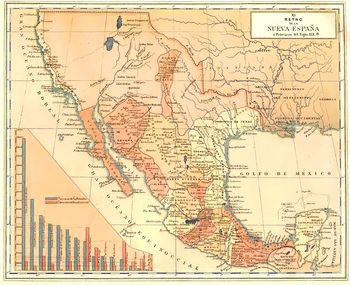 A map depicting New Spain around the turn of the 19th century. The California missions were situated within, and exerted influence over, the area identified in the upper left as "Nueva California," or "New" California.[1][2] A map depicting New Spain around the turn of the 19th century. The California missions were situated within, and exerted influence over, the area identified in the upper left as "Nueva California," or "New" California.[1][2]
| |
| Franciscan Establishments (1769–1823) | |
|---|---|
| Mission San Diego de Alcalá, founded in 1769 | |
| Mission San Carlos Borromeo de Carmelo, founded in 1770 | |
| Mission San Antonio de Padua, founded in 1771 | |
| Mission San Gabriel Arcángel, founded in 1771 | |
| Mission San Luis Obispo de Tolosa, founded in 1772 | |
| Mission San Francisco de Asís, founded in 1776 | |
| Mission San Juan Capistrano, founded in 1776 | |
| Mission Santa Clara de Asís, founded in 1777 | |
| Mission San Buenaventura, founded in 1782 | |
| Mission Santa Barbara, founded in 1786 | |
| Mission La Purísima Concepción, founded in 1787 | |
| Mission Santa Cruz, founded in 1791 | |
| Mission Nuestra Señora de la Soledad, founded in 1791 | |
| Mission San José, founded in 1797 | |
| Mission San Juan Bautista, founded in 1797 | |
| Mission San Miguel Arcángel, founded in 1797 | |
| Mission San Fernando Rey de España, founded in 1797 | |
| Mission San Luis Rey de Francia, founded in 1798 | |
| Mission Santa Inés, founded in 1804 | |
| Mission San Rafael Arcángel, founded in 1817 | |
| Mission San Francisco Solano, founded in 1823 | |
The Spanish missions in California consisted of twenty-one religious outposts (along with their associated dependencies) established by Spaniards of the Franciscan Order between 1769 and 1823. The mission outposts were situated along a 600-mile trail dubbed El Camino Real, or "The Royal Highway." Considered by the Spanish Empire to be the only viable method of spreading the Catholic faith among the local Native American populations, the missions represented the first major effort by Europeans to colonize the Pacific Coast region, and helped Spain enforce its 167-year-old claim to Alta California as established by Sebastián Vizcaíno in 1602. By the time that Spanish occupation efforts began in earnest in the late 1760s there were hundreds of tribes inhabiting the region, each with its own diverse culture and language. The settlers introduced European livestock, fruits, vegetables, and industry into the region. European contact was a momentous event, which profoundly affected California's native peoples. Ultimately, the mission system failed in its objective to convert, educate, and "civilize" the indigenous population in order to transform the California natives into Spanish colonial citizens, and therefore did not provide the anticipated economic benefits as well. The missions' unique design cues had a lasting influence on California architecture. A combination of natural disasters and neglect caused most of the mission structures to fall into ruin, though nearly all have since been rebuilt or restored. The ownership of all but two of the missions was returned to the Catholic Church via Presidential proclamations; Mission La Purísima Concepción and Mission San Francisco Solano are administered by the California Department of Parks and Recreation as State Historic Parks. Today, the missions are among the state's oldest structures and the most-visited historic monuments.
History
Precontact
The first human inhabitants of North America are thought to have made their homes among the southern valleys of California's coastal mountain ranges some 10,000 to 12,000 years ago; the earliest of these people are known only from archaeological evidence.[5][6][7] Over the course of thousands of years, California's diverse group of first settlers (later known as "Indians") evolved into hundreds of separate tribal groups, with an equally diverse range of languages, religions, dress, and other customs.[8][9] The tribes established comparatively peaceful cultures years before Spanish contact.
Early exploration and contact
By the time of the earliest European contacts, California was the most densely populated area north of Mexico.[10] Beginning in 1492 with the voyages of Christopher Columbus, the Kingdom of Spain sought to establish missions to convert the pagans in Nueva España ("New Spain," consisting of the Caribbean, Mexico and most of what today is the Southwestern United States) to Roman Catholicism, in order to facilitate colonization of these lands awarded to Spain by the Catholic Church, including that region known as Alta California.[11][12][13][14] However, it was not until 1741—the time of the Vitus Bering expedition, when the territorial ambitions of Tsarist Russia towards North America became known—that King Philip V felt such installations were necessary in Upper California.[15][16][17] California represents the "high-water mark" of Spanish expansion in North America, it being the last and northernmost colony on the continent.[18] The mission system arose in part from the need to control Spain's ever-expanding holdings in the New World. Realizing that the colonies would require a literate population base that the mother country could not supply, the government (with the cooperation of the Church) established a network of missions with the goal of converting the natives to Christianity; the aim was to make converts and tax paying citizens of the indigenous peoples they conquered.[19] In order to become Spanish citizens and productive inhabitants, the native Americans were required to learn Spanish language and vocational skills along with Christian teachings.[20] Estimates for the precontact native population in California have been based on a number of different sources (and therefore vary substantially), but indigenous peoples may have numbered as high as 300,000, divided into more than 100 separate tribes or nations.[21][22][23]
On January 29, 1767 King Charles III ordered the Jesuits, who had established a chain of fifteen missions throughout Baja California, forcibly expelled and returned to the home country.[24] Visitador General José de Gálvez engaged the Franciscans, under the leadership of Fray Junípero Serra, to take charge of those outposts on March 12, 1768.[25] The padres closed or consolidated several of the existing settlements, and also founded La Misión San Fernando Rey de España de Velicatá (the only Franciscan mission in all of Baja California) and the nearby Visita de la Presentación in 1769. This plan, however, was changed within a few months after Gálvez received the following orders: "Occupy and fortify San Diego and Monterey for God and the King of Spain." [26] It was thereupon decided to call upon the priests of the Dominican Order to take charge of the Baja California missions in order to allow the Franciscans to concentrate on founding new missions in Alta California.[27]
Founding
Expeditions
Prior to 1754, grants of mission lands were made directly by the Spanish Crown; however, given the remote locations and the inherent difficulties in communicating with the territorial governments, power was transferred to the viceroys of New Spain to grant lands and establish missions in North America.[28] The twenty-one Alta California missions were established along the northernmost section of California's El Camino Real (Spanish for "The Royal Highway," though often referred to as "The King's Highway", christened in honor of King Charles III of Spain), much of which is now U.S. Route 101 and several Mission Streets. The mission planning was begun in 1767 under the leadership of Fray Junípero Serra, O.F.M. (who, in 1767, along with his fellow priests, had taken control over a group of missions in Baja California previously administered by the Jesuits).
The Franciscans' first campaign into Upper California commenced in January of 1769. Four separate expeditions were undertaken in order to lessen the risk of failure,as well as to gain practical knowledge of both routes. Two groups marched out initially over land from the settlement at Loreto and two others departed aboard the only available vessels, the packet boats (small boats designed for the transportation of freight, passengers, and domestic mail) San Antonio and San Carlos (which sailed from the port of Cabo San Lucas and La Paz, respectively).[29] San Carlos shaped a course for San Diego on January 9, while San Antonio set sail on February 15.[30] The first land excursion set out from the settlement at Velicatá (some 200 miles south of Ensenada) on March 24 under the spiritual leadership of Father Fermín Francisco de Lasuén who, along with by Father Juan Crespí and a band of pilgrims, traveled under the protection of Captain Fernando Rivera, Lieutenant Pedro Fages, and twenty-five soldiers. Serra's party procured the necessary provisions from other missions situated along the Baja Peninsula and went forth on May 15.[31] San Antonio dropped anchor in San Diego on April 11, 1769; San Carlos, which had been reportedly "struggling with difficulties" including leaking water-casks, bad water, scurvy, and cold weather, did not arrive until April 29.[32] Almost the entire complement of both ships contracted scurvy, and out of some ninety sailors, soldiers, and mechanics, less than thirty survived. Lasuén's contingent arrived soon thereafter and immediately erected a permanent camp at what today is known as "Old San Diego." On June 29, Gaspar de Portolà (the first governor of Las Californias) arrived just two days ahead of the last band traveling under Serra, on July 1. On July 16, 1769, Father Serra raised a cross and held mass, thereby formally establishing the Mission of San Diego de Alcalá.[33]
Father Pedro Estévan Tápis proposed the establishment of a mission on one of California's Channel Islands in 1784, with either Santa Catalina or Santa Cruz Island (known as Limú to the inhabitants) being the most likely locations, the reasoning being that an offshore mission might have attracted potential converts who were not disposed to associate with a mainland outpost, and would have been an effective measure to restrict smuggling operations.[34] Though Governor José Joaquín de Arrillaga approved the plan the following year, an outbreak of sarampion (measles) that left some 200 natives dead, coupled with a scarcity of good lands and water, left the success of such a venture in doubt, and no attempt to found an island mission was ever made. In September, 1821 Father Mariano Payeras, "Comisario Prefecto" of the California missions, visited Cañada de Santa Ysabel as part of a plan to establish an entire string of inland missions, with the Santa Ysabel Asistencia as the "mother" mission. The plan never came to fruition, however. Work on the mission chain was concluded in 1823, even though Serra had died in 1784 (plans to establish a twenty-second mission in 1827 in Santa Rosa, where settlers from nearby Sonoma raised and slaughtered livestock at the fork of the Santa Rosa Creek and Matanzas Creek, were canceled).[35] Fray Lasuén took up the work after Serra's death and established nine more mission sites, from 1786 through 1798; others established the last three compounds, along with at least five asistencias.[36] At the peak of its development in 1832, the mission system controlled an area equal to approximately one-sixth of Alta California.[37] Two short-lived settlements, Mission Puerto de Purísima Concepción and Mission San Pedro y San Pablo de Bicuñer, though located on the California side of the Colorado River, were founded under the authority of the Arizona mission hierarchy and are therefore not included herein.
Site selection and layout
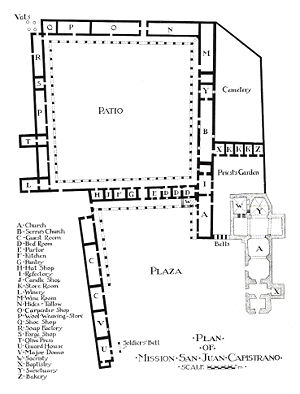
A plan view of the Mission San Juan Capistrano complex (including the footprint of the "Great Stone Church") prepared by architect Arthur B. Benton in 1916.[38]
In addition to the presidio (royal fort) and pueblo (town), the misión was one of the three major agencies employed by the Spanish sovereign to extend its borders and consolidate its colonial territories. Asistencias ("satellite" or "sub" missions, sometimes referred to as "contributing chapels") were small-scale missions that, by definition, boasted all of the requisites of a mission, and that conducted regular Divine Service on days of obligation, but lacked a resident priest.[39] As with the missions, these settlements were typically established in areas with high concentrations of potential native converts.[40] The Spanish Californians had never strayed from the coast when establishing their settlements; Mission Nuestra Señora de la Soledad was located farthest inland, being only some thirty miles (48 kilometers) from the shore.[41] Each frontier station was forced to be self-supporting, as existing means of supply were inadequate to maintain a colony of any size. California was literally months away from the nearest base in colonized Mexico, and the cargo ships of the day were too small to carry more than a few months’ rations in their holds. In order to sustain a mission, the padres required the help of colonists or converted Native Americans, called neophytes, to cultivate crops and tend livestock in the volume needed to support a fair-sized establishment. The scarcity of imported materials, together with a lack of skilled laborers, compelled the Fathers to employ simple building materials and methods in the construction of mission structures.
Although the missions were considered temporary ventures by the Spanish hierarchy, the development of an individual settlement was not simply a matter of "priestly whim." The founding of a mission followed longstanding rules and procedures; the paperwork involved required months, sometimes years of correspondence, and demanded the attention of virtually every level of the bureaucracy. Once empowered to erect a mission in a given area, the men assigned to it chose a specific site that featured a good water supply, plenty of wood for fires and building material, and ample fields for grazing herds and raising crops.[42] The padres blessed the site, and with the aid of their military escort fashioned temporary shelters out of tree limbs or driven stakes, roofed with thatch or reeds (cañas). It was these simple huts that would ultimately give way to the stone and adobe buildings which exist to this day.
The first priority when beginning a settlement was the location and construction of the church (iglesia). The majority of mission sanctuaries were oriented on a roughly east-west axis to take the best advantage of the sun's position for interior illumination; the exact alignment depended on the geographic features of the particular site. Once the spot for the church had been selected, its position would be marked and the remainder of the mission complex would be laid out. The workshops, kitchens, living quarters, storerooms, and other ancillary chambers were usually grouped in the form of a quadrangle, inside which religious celebrations and other festive events often took place. The cuadrángulo was rarely a perfect square because the Fathers had no surveying instruments at their disposal and simply measured off all dimensions by foot. Some fanciful accounts regarding the construction of the missions claimed that underground tunnels were incorporated in the design, to be used as a means of emergency egress in the event of attack; however, no historical evidence (written or physical) has ever been uncovered to support these assertions.[43]
Mission Period (1769 – 1833)
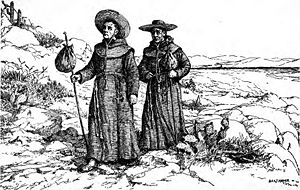
The Missionaries as They Came and Went. Franciscans of the California missions donned gray habits, in contrast to the brown cassocks that are typically worn today.[44]
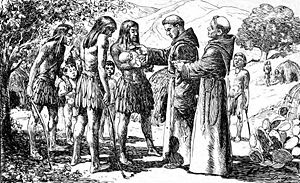
The first recorded baptisms in Alta California were performed in "The Canyon of the Little Christians." [45]
On July 14, 1769 Gálvez sent the expedition of Junípero Serra and Gaspar de Portolà from Loreto, in Baja California, to found a mission at San Diego and a presidio at Monterey, respectively.[48][49] As the planned colonization of Upper California was to be a spiritual as well as a military endeavor—with the founding of missions and conversion of Indians given at least equal weight to the establishment of presidios—the attempt to settle the northern country became known as the "Sacred Expedition." [50] En route to Monterey, Fathers Francisco Gómez and Juan Crespí came across a native settlement wherein two young girls were close to death: one, a baby said to be "dying at its mother's breast," the other a small girl suffering from severe burns. On July 22, Father Gómez baptized the baby, giving her the name "Maria Magdalena," while Father Crespí baptized the older child, naming her "Margarita;" these were the first recorded baptisms in Alta California.[51] The expedition's soldiers dubbed the spot Los Cristianos.[52] The group continued northward but missed Monterey Harbor and returned to San Diego on January 24, 1770. Near the end of 1771 the Portolà Expedition arrived at San Francisco Bay; between 1774 and 1791, the Spanish Crown sent forth a number of expeditions to explore the Pacific Northwest.
Each mission was to be turned over to a secular clergy and all the common mission lands distributed amongst the native population within ten years after its founding, a policy that was based upon Spain's experience with the more advanced tribes in Mexico, Central America, and Peru.[53] In time, it became apparent to Father Serra and his associates that the Indian tribes on the northern frontier in Alta California would require a much longer period of acclimatization.[54] None of the California missions ever attained complete self-sufficiency, and required continued (albeit modest) financial support from mother Spain.[55][56] Mission development was therefore financed out of El Fondo Piadoso de las Californias ("The Pious Fund of the Californias," which had its origin in 1697 and consisted of voluntary donations made by individuals and religious bodies in Mexico to members of the Society of Jesus) to enable the missionaries to propagate the Catholic Faith in the area then known as California. Starting with the onset of the Mexican War of Independence in 1810, this support largely disappeared and the missions and their converts were left on their own (as of 1800, native labor had made up the backbone of the colonial economy).[57] Arguably "the worst epidemic of the Spanish Era in California" was known to be the measles epidemic of 1806, wherein one-quarter of the mission Indian population of the San Francisco Bay area died of the measles or related complications between March and May of that year.[58] In 1811, the Spanish Viceroy in Mexico sent an interrogatorio (questionnaire) to all of the missions in Alta California regarding the customs, disposition, and condition of the Mission Indians.[59] The replies, which varied greatly in the length, spirit, and even the value of the information contained therein, were collected and prefaced by the Father-Presidente with a short general statement or abstract; the compilation was thereupon forwarded to the viceregal government.[60] The contemporary nature of the responses, no matter how incomplete or biased some may be, are nonetheless of considerable value to modern ethnologists.
Russian colonization of the Americas reached its southernmost point with the 1812 establishment of Fort Ross (krepost' rus), an agricultural, scientific, and fur-trading settlement located in present-day Sonoma County as an attempt to extend control to the federal territory of Alta California.[61][62] In November and December of 1818, several of the missions were attacked by Hipólito Bouchard, "California's only pirate." [63] A French privateer sailing under the flag of Argentina, Pirata Buchar (as he was known to the locals) worked his way down the California coast, conducting raids on the installations at Monterey, Santa Barbara, and San Juan Capistrano, with minimal success.[64] Upon hearing of the attacks, many mission priests (along with a few government officials) sought refuge at Mission Nuestra Señora de la Soledad, the mission chain's most isolated outpost. Ironically, Mission Santa Cruz (though ultimately ignored by the marauders) was ignominiously sacked and vandalized by local residents who were entrusted with securing the church's valuables.[65]
By 1819, Spain decided to limit its "reach" in the New World to Northern California due to the costs involved in sustaining these remote outposts; the northernmost settlement therefore is Mission San Francisco Solano, founded in Sonoma in 1823 at the direction of the Mexican government.[66] An attempt to found a twenty-second mission in Santa Rosa in 1827 was aborted.[67][68][69] As the Mexican republic matured, calls for the secularization ("disestablishment") of the missions increased.[70] José María de Echeandía, the first native Mexican to be elected Governor of Alta California, issued his "Proclamation of Emancipation" (or "Prevenciónes de Emancipacion") on July 25, 1826.[71] All Indians within the military districts of San Diego, Santa Barbara, and Monterey who were found qualified were freed from missionary rule and made eligible to become Mexican citizens. Those who wished to remain under mission tutelage were exempted from most forms of corporal punishment.[72][73] By 1830 even the neophyte populations themselves appeared confident in their own abilities to operate the mission ranches and farms independently; the padres, however, doubted the capabilities of their charges in this regard.[74] Ever-increasing immigration brought pressure to bear on local governments to seize the mission properties and disposses the natives in accordance with Echeandía's directive.[75] Despite the fact that Echeandía's emancipation plan met was met with little encouragement from the novices who populated the southern missions, he was nonetheless determined to test the scheme on a large scale at Mission San Juan Capistrano. To that end, he appointed a number of comisianados (commissioners) to oversee the emancipation of the Indians.[76] The Mexican government passed legislation on December 20, 1827 that mandated the expulsion of all Spaniards younger than sixty years of age from Mexican territories; Governor Echeandía nevertheless intervened on behalf of some of the missionaries in order to prevent their deportation once the law of took effect in California.[77]
Although Governor José Figueroa (who took office in 1833) initially attempted to keep the mission system intact, the Mexican Congress nevertheless passed An Act for the Secularization of the Missions of California on August 17, 1833.[78] The Act also provided for the colonization of both Alta and Baja California, the expenses of this latter move to be borne by the proceeds gained from the sale of the mission property to private interests.
Rancho Period (1834 – 1849)
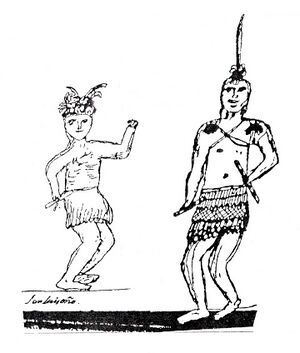
Pablo Tac, who lived at Mission San Luis Rey in the 1820s and 1830s, penned this drawing depicting two young men wearing skirts of twine and feathers with feather decorations on their heads, rattles in their hands, and (perhaps) painted decorations on their bodies.[79]
By way of confiscation of the missions between 1834 and 1838 the approximately 15,000 resident neophytes lost the protection of the mission system, along with their stock and other movable property. Mission San Juan Capistrano was the very first to feel the effects of secularization the following year when, on August 9, 1834 Governor Figueroa issued his "Decree of Confiscation." [80] Nine other settlements quickly followed, with six more in 1835; San Buenaventura and San Francisco de Asís were among the last to succumb, in June and December of 1836, respectively.[81] The Franciscans soon thereafter abandoned most of the missions, taking with them most everything of value, after which the locals typically plundered the mission buildings for construction materials. In spite of this neglect, the Indian towns at San Juan Capistrano, San Dieguito, and Las Flores did continue on for some time under a provision in Gobernador Echeandía's 1826 Proclamation that allowed for the partial conversion of missions to pueblos.[82] In 1895 journalist and historian Charles Fletcher Lummis criticized the Act and its results, saying:
Disestablishment—a polite term for robbery—by Mexico (rather than by native Californians misrepresenting the Mexican government) in 1834, was the death blow of the mission system. The lands were confiscated; the buildings were sold for beggarly sums, and often for beggarly purposes. The Indian converts were scattered and starved out; the noble buildings were pillaged for their tiles and adobes...[83]
Also in 1835, the Mexican Congress resolved that Alta California and Baja California should be divided into a separate diocese.[84] However, it was not until the issuance of a papal bull on April 27, 1840 that Father Diego y Moreno assumed the position of bishop of the Californias.[85] Some three years later, on March 29, 1843, Governor Manuel Micheltorena issued a decree that restored the temporal management of twelve of the missions to the resident priests with the proviso that one-eighth (⅛) of all proceeds be paid into the public treasury.[86] Pío de Jesus Pico IV, the last Mexican Governor of Alta California, found upon taking office that there were few funds available with which to carry on the affairs of the province. He prevailed upon the assembly to pass a decree authorizing the renting or the sale of all mission property, reserving only the church, a curate's house, and a building for a courthouse.[87] The expenses of conducting the services of the church were to be provided from the proceeds, but there was no disposition made as to what should be done to secure the funds for that purpose.
In December of 1844 acting governor of Alta California José Antonio Castro ordered that the Reverend José de Jesus del Mercado be forcibly seized and removed from Mission Santa Clara due to the padre's "subversive conduct" with regard to the appropriation of mission property by Mexican settlers. After secularization, Father Presidente Narciso Durán transferred the missions' headquarters to Santa Barbara, thereby making Mission Santa Barbara the repository of some 3,000 original documents that had been scattered through the California missions. The Mission archive is the oldest library in the State of California that still remains in the hands of its founders, the Franciscans (Santa Barbara is the only mission in which they have maintained an uninterrupted presence). Beginning with the writings of Hubert Howe Bancroft, the library has served as a center for historical study of the missions for more than a century. According to one estimate, the native population in and around the missions proper was approximately 80,000 at the time of the confiscation; others claim that the statewide population had dwindled to approximately 100,000 by the early 1840s, due in no small part to the natives' exposure to European diseases for which they lacked immunity, and from the Franciscan practice of cloistering women in the convento and controlling sexuality during the child-bearing age (Baja California experienced a similar drop in the number of indigenous inhabitants resulting from Spanish colonization efforts there).[88][89]
Upon execution of the Treaty of Guadalupe Hidalgo (which ended the Mexican–American War in 1848) the Mexican territory of Alta California became a United States territory, joining the Union in 1850.
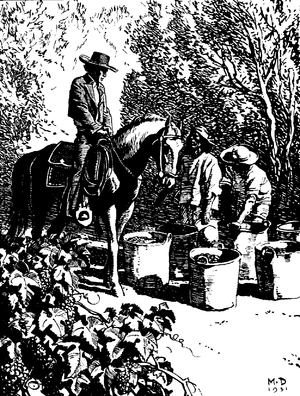
Hugo Reid, an outspoken critic of the mission system and its effects on the native populations, visits Rancho Santa Anita circa 1850.[90]
California Statehood (1850 and beyond)
The western territory of Alta California was granted statehood on September 9, 1850.[91] The transfer of California to the United States left the former mission inhabitants without legal title to their land. Throughout his second term of office, Alta California governor Pío Pico sold off mission lands in order to help fill the State's depleted coffers.[92][93] Via the Act of September 30, 1850, the U.S. Congress appropriated funds to allow the President to appoint three Commissioners to study the California situation and "...negotiate treaties with the various Indian tribes of California." Treaty negotiations ensued during the period between March 19, 1851 and January 7, 1852, during which time the Commission interacted with 402 Indian chiefs and headmen (representing approximately one-third to one-half of the California tribes) and entered into eighteen treaties.[94] California Senator William M. Gwin's Act of March 3, 1851 created the Public Land Commission, whose purpose was to determine the validity of Spanish and Mexican land grants in California.[95][96] On February 19, 1853 Archbishop Joseph Sadoc Alemany filed petitions for the return of all former mission lands in the state. Alemany's filings would not, however, see effect until some five years later (when, in March of 1858, James Buchanan initiated the first of a series of Presidential proclamations) that the process of restoration of mission lands to the Roman Catholic Church would commence.[97] Ownership of 1,051.44 acres (for all practical intents being the exact area of land occupied by the original mission buildings, cemeteries, and gardens) was subsequently conveyed to the Church, along with the Cañada de los Pinos (or College Rancho) in Santa Barbara County comprising 35,499.73 acres (143.6623 km²), and La Laguna in San Luis Obispo County, consisting of 4,157.02 acres (16.8229 km²).[98] As the result of a U.S. government investigation in 1873, a number of Indian reservations were assigned by executive proclamation in 1875. The commissioner of Indian affairs reported in 1879 that the number of Mission Indians in the state was down to around 3,000 with a total statewide population of less than 16,000 by 1900.[99][100]
The Mission Trail
Heavy freight movement was practical only via water. In order to facilitate overland travel, the mission settlements were situated approximately 30 miles (48 kilometers) apart, so that they were separated by one day's long ride on horseback (or three days on foot) along the 600-mile (966-kilometer) long "California Mission Trail." Father Lasuén is credited for having brought the concept to life in 1798 when he successfully argued that filling in the "spaces" along the route with additional outposts would provide much-needed rest stops, where travelers could take lodging in relative safety and comfort.[101] Tradition has it that the padres sprinkled mustard seeds along the trail in order to mark it with bright yellow flowers.[102]
Missions in geographical order, north to south
- Mission San Francisco Solano; located in the present-day City of Sonoma — originally planned as an asistencia to Mission San Rafael Arcángel
- Mission San Rafael Arcángel; located in the present-day City of San Rafael — originally planned as an asistencia to Mission San Francisco de Asís
- Mission San Francisco de Asís (Mission Dolores); located in the present-day City of San Francisco
- Mission San José; located in the present-day City of Fremont
- Mission Santa Clara de Asís; located in the present-day City of Santa Clara
- Mission Santa Cruz; located in the present-day City of Santa Cruz
- Mission San Juan Bautista; located in the present-day City of San Juan Bautista
- Mission San Carlos Borromeo de Carmelo; located south of the present-day City of Carmel-by-the-Sea
- Mission Nuestra Señora de la Soledad; located south of the present-day City of Soledad
- Mission San Antonio de Padua; located northwest of the present-day community of Jolon
- Mission San Miguel Arcángel; located in the present-day town of San Miguel
- Mission San Luis Obispo de Tolosa; located in the present-day City of San Luis Obispo
- Mission La Purísima Concepción; located northeast of the present-day City of Lompoc
- Mission Santa Inés; located in the present-day City of Solvang
- Mission Santa Barbara; located in the present-day City of Santa Barbara
- Mission San Buenaventura; located in the present-day City of Ventura
- Mission San Fernando Rey de España; located in the present-day community of Mission Hills (Los Angeles County)
- Mission San Gabriel Arcángel; located in the present-day City of San Gabriel
- Mission San Juan Capistrano; located in the present-day City of San Juan Capistrano
- Mission San Luis Rey de Francia; located in the present-day City of Oceanside
- Mission San Diego de Alcalá; located in the present-day City of San Diego
Asistencias in geographical order, north to south
- Santa Rosa de Lima Asistencia, founded circa 1828; located in present-day City of Santa Rosa
- Santa Eulalia Asistencia, founded circa 1827; located in the present-day City of Rockville
- San Pedro y San Pablo Asistencia, founded in 1786; located in the present-day City of Pacifica
- Santa Paula Asistencia, founding date unknown; located in the present-day City of Santa Paula
- Santa Margarita de Cortona Asistencia, a visita (country chapel) founded in 1787; located in the present-day community of Santa Margarita
- Nuestra Señora Reina de los Angeles Asistencia, founded in 1784; located in the present-day City of Los Angeles
- San Antonio de Pala Asistencia ("Pala Mission"), founded in 1816; located in present-day eastern San Diego County
- Santa Ysabel Asistencia, founded in 1818; located in the present-day community of Santa Ysabel
Estancias in geographical order, north to south
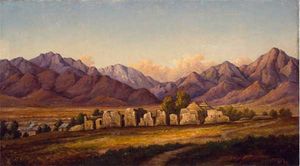
The San Bernardino de Sena Estancia, today often referred to as "The Asistencia," circa 1880-1881.

Las Flores Estancia's "San Pedro Chapel" as it appeared around 1850.[103] The structure, along with its adjoining buildings, were constructed in 1823.[104]
Listed below are the major estancias; the missions with which each ranch was associated are displayed in parentheses.
- Rancho Refugio (Santa Cruz)
- Rancho San Bartolome (San Antonio de Padua)
- Rancho San Miguelito (San Antonio de Padua)
- Rancho San Antonio de los Ajitos (San Antonio de Padua)
- Rancho San Benito (San Antonio de Padua)
- Rancho Aguage (San Miguel)
- Rancho Asunción (San Miguel)
- Rancho San Simeon (San Miguel)
- Rancho San Miguelito (San Luis Obispo)
- Rancho Arroyo Grande (San Luis Obispo)
- Santa Margarita (San Luis Obispo)
- Rancho de la Playa (San Luis Obispo)
- Rancho San Antonio (La Purísima)
- Rancho San Marcos (Santa Barbara)
- Rancho San Franciso Xavier (San Fernando)
- Rancho San Bernardino (San Gabriel)
- Rancho Santa Anita (San Gabriel)
- Santa Ana Estancia (San Juan Capistrano)
- Las Flores Estancia (San Luis Rey)
- Valle de San Luis (San Diego)
El Camino Real
The "Mission Bell Marker" system has existed on the historic route of El Camino Real (designated as California Historical Landmark #784, "As Father Serra Knew It and Helped Blaze It"),[109][110] since August 15, 1906, when the first of over 450 pole-mounted 85 pound (39 kilogram) cast iron markers was placed on the grounds of La Iglesia de Nuestra Señora Reina de los Angeles in the Pueblo of Los Angeles. The bells were inscribed, "El Camino Real 1769-1906," the dates referencing the period between the founding of the first mission in 1769 and the dedication of the first bell. The work required to place a bell along each mile (1.6 kilometers) of the Highway and one at each mission was completed in 1913. Over time many bells were lost due to road reconstruction and theft. The bell marker system as originally envisioned was realized in early 2005 with the installation of new 18 inch (46 cm) diameter cast metal bell assemblies manufactured using the original molds to fabricate the bells.
Headquarters of the Alta California Mission System
- Mission San Diego de Alcalá (1769–1771)
- Mission San Carlos Borromeo de Carmelo (1771–1815)
- Mission La Purísima Concepción* (1815–1819)
- Mission San Carlos Borromeo de Carmelo (1819–1824)
- Mission San José* (1824–1827)
- Mission San Carlos Borromeo de Carmelo (1827–1830)
- Mission San José* (1830–1833)
- Mission Santa Barbara (1833–1846)
* Fathers Payeras and Durán remained at their resident missions during their terms as "Father-Presidente," therefore those settlements became the de facto headquarters (until 1833, when all mission records were permanently relocated to Santa Barbara).[111][112]
Military Districts
California during the Mission Period was divided into four military districts. Four presidios, strategically placed along the California coast, served to protect the missions and other Spanish settlements in Upper California.[113] Presidios were not fortresses, nor were they commanded or manned by trained military personnel (though presidial captains were often Spaniards with military experience); these men were more akin to militiamen than traditional soldiers.[114] Each of the comandancias (garrisons) functioned as a base of military operations for a specific region. Although independent of one another, a sort of unison or connection existed among the missions of each district, which were organized as follows:
- El Presidio Real de San Diego, founded on July 16, 1769 [115] — responsible for the defense of all installations located within the First Military District (the missions at San Diego, San Luis Rey, San Juan Capistrano, and San Gabriel);[116]
- El Presidio Real de Santa Bárbara, founded on April 12, 1782 [117] — responsible for the defense of all installations located within the Second Military District (the missions at San Fernando, San Buenaventura, Santa Barbara, Santa Inés, and La Purísima, along with El Pueblo de Nuestra Señora la Reina de los Ángeles del Río de Porciúncula [Los Angeles]);[118]
- El Presidio Real de San Carlos de Monterey (El Castillo), founded on June 3, 1770 [119] — responsible for the defense of all installations located within the Third Military District (the missions at San Luis Obispo, San Miguel, San Antonio, Soledad, San Carlos, and San Juan Bautista, along with Villa Branciforte [Santa Cruz]);[120] and
- El Presidio Real de San Francisco, founded on December 17, 1776 [121] — responsible for the defense of all installations located within the Fourth Military District (the missions at Santa Cruz, San José, Santa Clara, San Francisco, San Rafael, and Solano, along with El Pueblo de San José de Guadalupe).[122]
El Presidio de Sonoma, or "Sonoma Barracks" (a collection of guardhouses, storerooms, living quarters, and an observation tower) was established in 1836 by Mariano Guadalupe Vallejo (the "Commandante-General of the Northern Frontier of Alta California") as a part of Mexico's strategy to halt Russian incursions into the region.[123] The Sonoma Presidio became the new headquarters of the Mexican Army in California, while the remaining presidios were essentially abandoned and, in time, fell into ruins.
An ongoing power struggle between church and state grew increasingly heated and lasted for decades. Originating as a feud between Father Serra and Pedro Fages (the military governor of Alta California from 1770 to 1774, who regarded the Spanish installations in California as military institutions first and religious outposts second), the uneasy relationship persisted for more than sixty years.[124][125] Dependent upon one another for their very survival, military leaders and mission padres nevertheless adopted conflicting stances regarding everything from land rights, the allocation of supplies, protection of the missions, the criminal propensities of the soldiers, and (in particular) the status of the native populations.[126]
Mission life
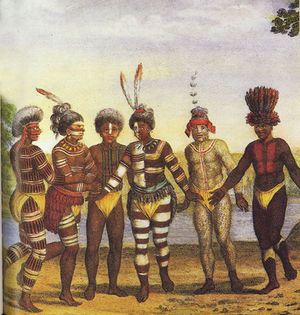
Georg von Langsdorff, an early visitor to California, sketched a group of Costeño dancers at Mission San José in 1806.[127][128]
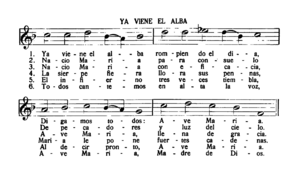
"Ya Viene El Alba" ("The Dawn Already Comes"), typical of the hymns sung at the missions.[129]
The Alta California missions were of a type known as reduccíones (reductions) or congregacíones (congregations), a concept developed in the late 16th century to be employed wherever the indigenous populations were not already concentrated in native pueblos; Indians were congregated around the mission proper through the use of various means, whereupon they were "reduced" from their "free, undisciplined" state and ultimately converted into civilized members of colonial society.[130][131][132] A total of 146 Friars Minor, all of whom were ordained as priests (and mostly Spaniards by birth) served in California between 1769–1845. 67 missionaries died at their posts (two as martyrs: Padres Luís Jayme and Andrés Quintana), while the remainder returned to Europe due to illness, or upon completing their ten-year service commitment.[133] As the rules of the Franciscan Order forbade friars to live alone, two missionaries were assigned to each settlement, sequestered in the mission's convento.[134] To these the governor assigned a guard of five or six soldiers under the command of a corporal, who generally acted as steward of the mission's temporal affairs, subject to the fathers' direction.[54]
Life at the California missions varied slightly throughout the entire system. Once a "gentile" was baptized, he or she became a neophyte, or new believer. This happened only after a brief period during which the initiates were instructed in the most basic aspects of the Catholic faith. But, while many natives were lured to join the missions out of curiosity and sincere desire to participate and engage in trade, many found themselves trapped once they received the sacrament of baptism. To the padres, a baptized Indian was no longer free to move about the country, but had to labor and worship at the mission under the strict observance of the fathers and overseers, who herded them to daily masses and labors. If an Indian did not report for their duties for a period of a few days a search was made (as required by Spanish law). If it was discovered that the individual left without permission, he or she was considered a runaway and subject to punishment.[135] A total of 20,355 natives were "attached" to the California missions in 1806 (the highest figure recorded during in the Mission Period); under Mexican rule the number rose to 21,066 (in 1824, the record year during the entire era of the Franciscan missions).[136]
Young native women were required to reside in the monjério (or "nunnery") under the supervision of a trusted Indian matron (the maestra, or "instructress") who bore the responsibility for their welfare and education.[137] Women only left the convent after they had been "won" by an Indian suitor and were deemed ready for marriage. Following Spanish custom, courtship took place on either side of a barred window. After the marriage ceremony the woman moved out of the mission compound and into one of the family huts.[138] These "nunneries" were considered a necessity by the priests, who felt the women needed to be protected from the men, both Indian and de razón. The cramped and unsanitary conditions the girls lived in contributed to the fast spread of disease and population decline. So many died at times that many of the Indian residents of the missions urged the fathers to raid new villages to supply them with more women. As of December 31, 1832 (the peak of the mission system's development) the mission padres had performed a combined total of 87,787 baptisms and 24,529 marriages, and recorded 63,789 deaths.[139]
Bells were vitally important to daily life at any mission. The bells were rung at mealtimes, to call the Mission residents to work and to religious services, during births and funerals, to signal the approach of a ship or returning missionary, and at other times; novices were instructed in the intricate rituals associated with the ringing the mission bells. The daily routine began with sunrise Mass and morning prayers, followed by instruction of the natives in the teachings of the Roman Catholic faith.[140] After a generous (by era standards) breakfast of atole (a traditional masa-based Mexican hot drink), the able-bodied men and women were assigned their tasks for the day. The women were committed to dressmaking, knitting, weaving, embroidering, laundering, and cooking, while some of the stronger girls would grind flour or carry adobe bricks (weighing 55 pounds, or 25 kilograms, each) to the men engaged in building. The men were tasked with a variety of jobs, having learned from the missionaries how to plow, sow, irrigate, cultivate, reap, thresh, and glean. In addition, they were taught to build adobe houses, tan leather hides, shear sheep, weave rugs and clothing from wool, make ropes, soap, paint, and other useful duties.
The work day was six hours, interrupted by dinner (lunch) around 11:00 a.m. and a two-hour siesta, and ended with evening prayers and the rosary, supper, and social activities. About 90 days out of each year were designated as religious or civil holidays, free from manual labor. The labor organization of the missions resembled a slave plantation in many respects.[141] Foreigners who visited the missions remarked at how the priests' control over the Indians appeared excessive, but necessary given the white men's isolation and numeric disadvantage.[142] Indians were not paid wages as they were not considered free laborers and, as a result, the missions were able to extract surplus value for the goods produced by the Mission Indians to the detriment of the other Spanish and Mexican settlers of the time who could not compete economically with the advantage of the mission system.[143] In recent years, much debate has arisen as to the actual treatment of the Indians during the Mission period, and many claim that the California mission system is directly responsible for the decline of the native cultures.[144] Evidence has now been brought to light that puts the Indians' experiences in a very different context.[145][146]
The missionaries of California were by-and-large well-meaning, devoted men...[whose] attitudes toward the Indians ranged from genuine (if paternalistic) affection to wrathful disgust. They were ill-equipped—nor did most truly desire—to understand complex and radically different Native American customs. Using European standards, they condemned the Indians for living in a "wilderness," for worshipping false gods or no God at all, and for having no written laws, standing armies, forts, or churches.[147]
Father-Presidents of the Alta California Mission System
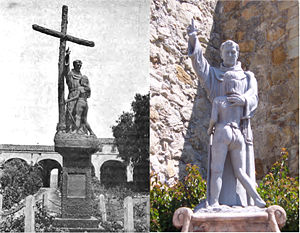
A statue of Father Junípero Serra blessing a Juaneño Indian boy depicts the meeting of the two cultures; a replica of the original rough wooden cross raised during Mission San Juan Capistrano's founding once adorned this piece (left).[148]
- Father Junípero Serra (1769–1784)
- Father Francisco Palóu (presidente pro tempore) (1784–1785)
- Father Fermín Francisco de Lasuén (1785–1803)
- Father Pedro Estévan Tápis (1803–1812)
- Father José Francisco de Paula Señan (1812–1815)
- Father Mariano Payéras (1815–1820)
- Father José Francisco de Paula Señan (1820–1823)
- Father Vicente Francisco de Sarría (1823–1824)
- Father Narciso Durán (1824–1827)
- Father José Bernardo Sánchez (1827–1831)
- Father Narciso Durán (1831–1838)
- Father José Joaquin Jimeno (1838–1844)
- Father Narciso Durán (1844–1846)
The "Father-Presidente" was the head of the Catholic missions in Alta and Baja California. He was appointed by the College of San Fernando de Mexico until 1812, when the position became known as the "Commissary Prefect" who was appointed by the Commissary General of the Indies (a Franciscan residing in Spain). Beginning in 1831, separate individuals were elected to oversee Upper and Lower California.[149]
Mission industries
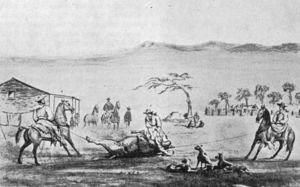
"The California Method" of killing cattle on the ranch, before 1875. Two cowboys on horseback have roped the steer by its hind legs and horns, respectively and have stretched it immobile so that the third cowboy, at center, is able to safely slit the throat of the bull with the knife he holds.
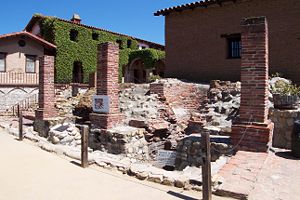
A view of the Catalan forges at Mission San Juan Capistrano (built circa 1790), the oldest existing facilities of their kind in the State of California. The sign at the lower right-hand corner proclaims the site as being "...part of Orange County's first industrial complex."
The goal of the missions was, above all, to become self-sufficient in relatively short order. Farming, therefore, was the most important industry of any mission. Barley, maize, and wheat were among the most common crops grown. Cereal grains were dried and ground by stone into flour. Even today, California is well-known for the abundance and many varieties of fruit trees that are cultivated throughout the state. The only fruits indigenous to the region, however, consisted of wild berries or grew on small bushes. Spanish missionaries brought fruit seeds over from Europe, many of which had been introduced to the Old World from Asia following earlier expeditions to the continent; orange, grape, apple, peach, pear, and fig seeds were among the most prolific of the imports. Grapes were also grown and fermented into wine for sacramental use and again, for trading. The specific variety, called the Criolla or "Mission grape," was first planted at Mission San Juan Capistrano in 1779; in 1783, the first wine produced in Alta California emerged from the mission's winery. Mission San Gabriel Arcángel would unknowingly witness the origin of the California citrus industry with the planting of the region’s first significant orchard in 1804, though the commercial potential of citrus would not be realized until 1841.[150] Olives (first cultivated at Mission San Diego de Alcalá) were grown, cured, and pressed under large stone wheels to extract their oil, both for use at the mission and to trade for other goods. Father Serra set aside a portion of the Mission Carmel gardens in 1774 for tobacco plants, a practice which soon spread throughout the mission system.[151]
It was also the missions' responsibility to provide the Spanish forts, or presidios, with the necessary foodstuffs, and manufactured goods to sustain operations. It was a constant point of contention between missionaries and the soldiers as to how many fanegas [152] of barley, or how many shirts or blankets the mission had to provide the garrisons on any given year. At times these requirements were hard to meet, especially during years of drought, or when the much anticipated shipments from the port of San Blas failed to arrive. The Spaniards kept meticulous records of mission activities, and each year reports submitted to the Father-Presidente summarizing both the material and spiritual status at each of the settlements.
Livestock was raised, not only for the purpose of obtaining meat, but also for wool, leather, and tallow, and for cultivating the land. In 1832, at the height of their prosperity, the missions collectively owned:
- 151,180 head of cattle;
- 137,969 sheep;
- 14,522 horses;
- 1,575 mules or burros;
- 1,711 goats; and
- 1,164 swine.[153]
All of these animals were originally brought up from Mexico. A great many Indians were required to guard the herds and flocks, which created the need for "...a class of horsemen scarcely surpassed anywhere." [54] These animals multiplied beyond the settler's expectations, often overrunning pastures and extending well-beyond the domains of the missions. The giant herds or horses and cows took well to the climate and the extensive pastures of the Coastal California region, but at a heavy price for the Native inhabitants. The uncontrolled spread of these new species quickly exhausted the grasslands and hillsides the Indians depended on for their seed harvests. This problem was also recognized by the Spaniards themselves, who at times sent out extermination parties to kill thousands of excess livestock, when the populations grew beyond their control. Mission kitchens and bakeries prepared and served thousands of meals each day. Candles, soap, grease, and ointments were all made from tallow (rendered animal fat) in large vats located just outside the west wing. Also situated in this general area were vats for dyeing wool and tanning leather, and primitive looms for weavings. Large bodegas (warehouses) provided long-term storage for preserved foodstuffs and other treated materials. Settlements had to fabricate virtually all needed construction materials from local resources. Workers in the carpintería (carpentry shop) used crude methods to shape beams, lintels, and other structural elements; more skilled artisans carved doors, furniture, and wooden implements. For certain applications bricks (ladrillos) were fired in ovens (kilns) to strengthen them and make them more resistant to the elements; when tejas (roof tiles) eventually replaced the conventional jacal roofing (densely-packed reeds) they were placed in the kilns to harden them as well. Glazed ceramic pots, dishes, and canisters were also made in mission kilns.
Prior to the establishment of the missions, the native peoples relied on their tribal knowledge in the use of a wide array of local materials including bone, seashells, stone, and wood, as well as handed-down techniques in tool and weapon making.[154] The missionaries' viewpoint, however, was that the Indians, who lacked experience in the Old World crafts, had to be taught industry in order to learn how to be self-sufficient (even though the natives had supported themselves for millennia). The result was the establishment of a great manual training school that comprised agriculture, the mechanical arts, and the raising and care of livestock. In time, a majority of the materials consumed and otherwise utilized by the natives was produced at the missions under the supervision of the padres; thus, the neophytes not only supported themselves in their new settings, but after 1811 sustained the entire military and civil government of California.[155] The foundry at Mission San Juan Capistrano was the first to introduce the Indians to the Iron Age. The blacksmith used the mission’s Catalan furnaces (California’s first) to smelt and fashion iron into everything from basic tools and hardware (such as nails) to crosses, gates, hinges, even cannon for mission defense. Iron was one commodity in particular that the mission relied solely on trade to acquire, as the missionaries had neither the know-how nor the technology to mine and process metal ores.
No study of the missions would be complete without mention of their extensive water supply systems. Stone zanjas (aqueducts), sometimes spanning miles, brought fresh water from a nearby river or spring to the mission site. Baked clay pipes, joined together with lime mortar or bitumen, deposited the water into large cisterns and gravity-fed fountains, and emptied into waterways where the force of the water was used to turn grinding wheels and other simple machinery, or dispensed for use in cleaning. Water used for drinking and cooking was allowed to trickle through alternate layers of sand and charcoal to remove the impurities.
Legacy
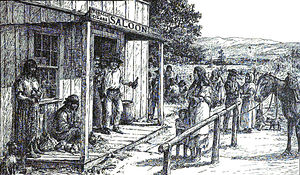
"Causes of Indian ruin: The White Man's greed; the White Man's vices and diseases; the White Man's whiskey." [156]

A view of Mission San Juan Capistrano in April of 2005. The Mission has earned a reputation as the "Loveliest of the Franciscan Ruins." [157]
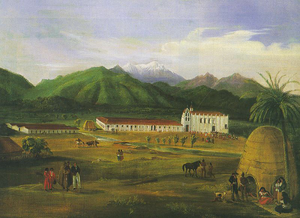
Mission San Gabriel Arcángel in 1832. The work is believed to be the earliest known oil landscape of Southern California.
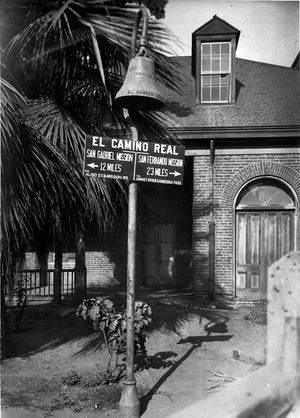
The bell of El Camino Real at La Iglesia de Nuestra Señora Reina de los Angeles, also known as the Los Angeles Plaza Church ("La Placita").

The San Gabriel Mission Playhouse (built in 1927), modeled after the Mission San Antonio de Padua in Monterey County.
Many, though not all, modern anthropologists cite a cultural bias on the part of the missionaries that blinded them to the natives' plight and caused them to develop strong negative opinions of the California Indians.[158][159] Recent scholarly interest in the subject has helped to overcomes these prejudices, though centuries of forced acculturation and the lack of written sources predating European conquest make it highly unlikely that a complete understanding of the primordial religious practices will ever be possible.[160] Fray Gerónimo Boscana, a Franciscan scholar who was stationed at Mission San Juan Capistrano for more than a decade beginning in 1812, compiled what is widely considered to be the most comprehensive study of prehistoric religious practices in the San Juan Capistrano valley.[161] The appellation "Mission Indians" was coined in 1906 as regarded California's native American population by Alfred L. Kroeber and Constance Du Bois, as an ethnographic and anthropological label collectively intended to refer to those groups that wee attached to the missions beginning at San Diego and extending up to San Luis Obispo.[162] The modern usage of the term generally applies to all tribal groups that resided within the mission system's sphere of influence. The California Gold Rush and subsequent American settlement had even more devastating effects on the native populations than did Spanish colonization, homicide being the greatest factor in their reduction.[163] It should be noted that these attrition rates are not unique to the Pacific Coastal region; virtually every area subjected to European colonization worldwide suffered similar deleterious effects.[164]
From an architectural and cultural standpoint, no other group of structures in the United States elicits the intense interest inspired by the missions of California (California is home to the greatest number of well-preserved missions found in any U.S. state).[165] The missions are collectively the best-known historic element of the coastal regions of California:
- All but two of the missions proper are owned and operated by the Catholic Church, as well as the Mission San Antonio de Pala, which was originally established as the San Antonio de Pala Asistencia (Mission La Purísima Concepción and Mission San Francisco Solano are administered by the California Department of Parks and Recreation as State Historic Parks);
- Nine mission sites are designated as National Historic Landmarks, sixteen are listed in the National Register of Historic Places (plus the related Las Flores Estancia), and all are designated as California Historical Landmarks for their historic, architectural, and archaeological significance;
- Four of the missions still run under the auspices of the Franciscan Order (San Antonio de Padua, Santa Barbara, San Miguel Arcángel, and San Luis Rey de Francia); and
- Four of the missions (San Diego de Alcalá, San Carlos Borromeo de Carmelo, San Francisco de Asís, and San Juan Capistrano) have been designated minor basilicas by the Holy See due to their cultural, historic, architectural, and religious importance.
Because virtually all of the artwork at the missions served either a devotional or didactic purpose, there was no underlying reason for the mission residents to record their surroundings graphically; visitors, however, found them to be objects of curiosity.[166] During the 1850s a number of artists found gainful employment as draftsmen attached to expeditions sent to map the Pacific coastline and the border between California and Mexico (as well as plot practical railroad routes); many of the drawings were reproduced as lithographs in the expedition reports. In 1875 American illustrator Henry Chapman Ford began visiting each of the twenty-one mission sites, where he created a historically-important portfolio of watercolors, oils, and etchings. His depictions of the missions were (in part) responsible for the revival of interest in the state's Spanish heritage, and indirectly for the restoration of the missions. The 1880s saw the appearance of a number of articles on the missions in national publications and the first books on the subject; as a result, a large number of artists did one or more mission paintings, though few attempted series.[166][167] The continued popularity of the missions also stems largely from Helen Hunt Jackson's 1884 novel Ramona and the subsequent efforts of Charles Fletcher Lummis, William Randolph Hearst, and other members of the "Landmarks Club of Southern California" to restore four of the missions in the early 20th century (those being San Juan Capistrano, San Diego, San Fernando, and Pala).[168] Lummis wrote in 1895,
In ten years from now—unless our intelligence shall awaken at once—there will remain of these noble piles nothing but a few indeterminable heaps of adobe. We shall deserve and shall have the contempt of all thoughtful people if we suffer our noble missions to fall. [169]
In acknowledgement of the magnitude of the restoration efforts required and the urgent need to have acted quickly to prevent further or even total degradation, Lummis went on to state,
It is no exaggeration to say that human power could not have restored these four missions had there been a five year delay in the attempt.[170]
In 1911 author John Steven McGroarty penned The Mission Play, a three-hour pageant describing the California missions from their founding in 1769 through secularization in 1834, and ending with their "final ruin" in 1847. In the early 1930s, teams from the Historic American Buildings Survey {HABS} visited sixteen mission sites (as well as the San Antonio de Pala Asistencia and Los Angeles Plaza Church) and conducted "multi-format surveys" comprised of the preparation of measured drawings, the taking of large-format photographs, and the collection of historic documents.[171] Today, the missions exist in varying degrees of architectural integrity and structural soundness. In some cases (at San Rafael, Santa Cruz, and Soledad, for example), the current buildings are replicas constructed on or near the original site. Other mission compounds remain relatively intact and true to their original, Mission Era construction. A notable example of an intact complex is the Mission San Miguel Arcángel: its chapel retains the original interior murals created by Salinan Indians under the direction of Esteban Munras, a Spanish artist and the last Spanish diplomat to California. Many missions have preserved (or in some cases reconstructed) historic features in addition to chapel buildings. The missions have earned a prominent place in California's historic consciousness, and a steady stream of tourists from all over the world visit them. The "California 4th Grade Mission Project" requires fourth-grade students in enrolled California public schools to (at minimum) conduct research into, and prepare a report on, the missions.
On November 30, 2004 President George W. Bush signed into law H.R. 1446, the "California Missions Preservation Act," a measure which would have provided (on a one-to-one matching basis) up to $10 million in funding to the California Missions Foundation over over a five-fiscal-year period for projects related to the physical preservation of the missions, including structural rehabilitation, stabilization, and conservation of mission art and artifacts.[172] However, Americans United for Separation of Church and State (a Washington D.C.-based lobbying group) immediately thereafter filed a federal lawsuit challenging the constitutionality of the Act, which (though the case never went to trial) effectively blocked issuance of the funding.[173] In 2006, an amendment to the California Constitution was sought by California State Senator Abel Maldonado that would have allowed the use of State funds in restoration efforts under California's Proposition 40, and endowment fund that goes to the preservation and restoration of state historical and cultural resources (the Constitution prohibits giving public aid to "support or sustain a sectarian institution"). The proposed measure failed to garner the required two-thirds votes in both houses needed to place the issue on the State's ballot.[174] Today, the missions attract millions of visitors each year, and rank among the top tourist destinations in the state.[175]
Folklore
The largest California pepper tree (Schinus molle) in the United States once graced the grounds of Mission San Juan Capistrano (until 2005, when it was felled due to illness).[176] The 57-foot (17-meter) tall specimen, planted in the 1870s, was typical of the early California landscape; it was also listed in the National Register of Big Trees. The oldest pepper tree in California resides in the courtyard of Mission San Luis Rey de Francia.[177]
See also
- Mission Buenaventura-class oiler, a series of twenty-seven T2 tankers built during World War II for auxiliary service in the United States Navy.
Notes and references
- ↑ (PD) Drawing: Antonio García Cubas
- ↑ Saunders and Chase, p. 65
- ↑ Rawls, p. 29: The temporary shelters were utilized primarily for sleeping or as refuge in cases of inclement weather. Europeans generally regarded such contrivances as "...evidence of the Indians' inability to fashion more sophisticated structures."
- ↑ Paddison, pp. 81-82: In the late 1780s, French naval officer and explorer Jean-François de Galaup, comte de La Pérouse described the native dwellings in and around Monterey—consisting of long poles stuck in the ground and drawn together to form arches, then covered with thatch—as "...the most miserable that are to be met with among any people." British naval officer and explorer George Vancouver documented similar conditions as observed during his 1792 visit to the San Francisco Bay area in A Voyage of Discovery to the North Pacific Ocean.
- ↑ Paddison, p. 333: The first indisputable archaeological evidence of human presence in California dates back to circa 8,000 BCE.
- ↑ Jones and Klar 2005, pp. 369-400: Recent research suggests that the Chumash may have been visited by Polynesians between 400 and 800 CE, nearly 1,000 years before Columbus reached North America. Although the concept was generally rejected for decades and remains controversial, studies published in peer-reviewed journals have given the idea greater plausibility.
- ↑ Jones and Klar 2007, p. 53: "Understanding how and when humans first settled California is intimately linked to the initial colonization of the Americas."
- ↑ Margolin, pp. 2-6
- ↑ Oakley, p. 1172
- ↑ Paddison, p. x
- ↑ The Spanish claim to the Pacific Northwest had dated back to a 1493 papal bull (Inter caetera) issued by Pope Alexander VI and rights contained in the 1494 Treaty of Tordesillas; these two formal acts gave Spain the exclusive rights to colonize all of the Western Hemisphere (save for Brazil), including the west coast of North America.
- ↑ The term "Alta California" as applies to the mission chain founded by Serra refers specifically to the modern-day U.S. State of California.
- ↑ Paddison, p. xii: Despite Vizcaíno's recommendations, the Spanish government felt that Alta California was too distant to effectively colonize, and at the same time too close to Mexico to warrant the establishment of a port at San Diego; a royal order prohibiting further exploration of the region was issued in 1606.
- ↑ Leffingwell, p. 10: Father Antonio de la Ascensión, a Carmelite priest who visited San Diego with Vizcaíno's 1602 expedition, "surveyed the area and concluded that the land was fertile, the fish plentiful, and gold abundant." Ascensión was convinced that California's potential wealth and strategic location merited colonization, and in 1620 recommended in a letter to Madrid that missions be established in the region, a venture that would involve military as well as religious personnel.
- ↑ Morrison, p. 214: During his voyage of exploration along the Pacific Coast of North America in 1579, Sir Francis Drake claimed the region (which he dubbed Nova Albion, Latin for "New Britain") in the name of England, a full generation before the first landing in Jamestown, Virginia. In order to preserve an uneasy peace with Spain, and to avoid having Spain threaten England's claims in the New World, both the discovery of and claim on New Albion was ordered by Queen Elizabeth I to be treated as a state secret.
- ↑ Chapman, p. 216: "It is usually stated that the Spanish court at Madrid received reports about Russian aggressions in the Pacific northwest, and sent orders to meet them by the occupation of Alta California, wherefore the expeditions of 1769 were made. This view contains only a smattering of the truth. It is evident from [José de] Gálvez's correspondence of 1768 that he and [Carlos Francisco de] Croix had discussed the advisability of an immediate expedition to Monterey, long before any word came from Spain about the Russian activities."
- ↑ Bennett 1897a, pp. 11-12: California had been visited a number of times since Juan Rodríguez Cabrillo’s discovery in 1542, which initially included notable expeditions led by Englishmen Francis Drake in 1579 and Thomas Cavendish 1587, and later on by Woodes Rogers (1710), George Shelvocke (1719), James Cook (1778), and finally George Vancouver in 1792. Spanish explorer Sebastián Vizcaíno made landfall in San Diego Bay in 1602, and the famed conquistador Hernán Cortés explored the California Gulf Coast in 1735.
- ↑ Rawls, p. 3
- ↑ Bennett 1897a, p. 10: "Other pioneers have blazed the way for civilization by the torch and the bullet, and the red man has disappeared before them; but it remained for the Spanish priests to undertake to preserve the Indian and seek to make his existence compatible with a higher civilization."
- ↑ "Old Mission Santa Inés:" Per clerical historian Maynard Geiger, "This was to be a cooperative effort, imperial in origin, protective in purpose, but primarily spiritual in execution."
- ↑ Rawls, p. 6
- ↑ Kroeber 1925, p. vi.: "In the matter of population, too, the effect of Caucasian contact cannot be wholly slighted, since all statistics date from a late period. The disintegration of native numbers and native culture have proceeded hand in hand, but in very different rations according to locality. The determination of population strength before the arrival of whites is, on the other hand, of considerable significance toward the understanding of Indian culture, on account of the close relations which are manifest between type of culture and density of population."
- ↑ Chapman, p. 383: "...there may have been about 133,000 [native inhabitants] in what is now the state as a whole, and 70,000 in or near the conquered area. The missions included only the Indians of given localities, though it is true that they were situated on the best lands and in the most populous centers. Even in the vicinity of the missions, there were some unconverted groups, however."
- ↑ Bennett 1897a, p. 15: Due to the isolation of the Baja California missions, the decree for expulsion did not arrive in June of 1767, as it did in the rest of New Spain, but was delayed until the new governor, Portolà, arrived with the news on November 30. Jesuits from the operating missions gathered in Loreto, whereupon they left for exile on February 3, 1768.
- ↑ Bennett 1897a, p. 16
- ↑ James, p. 11
- ↑ Guest: "The blueprint for Alta California provided for a system of settlements significantly different from those in Baja California and Sonora. In their original design, both presidios and missions were different from their predecessors to the south. The plan to make the presidios agriculturally productive did not succeed. Neither did the plan for the mission-pueblos as racially integrated nuclei of urban centers, but the ideal of a closer association between "missionized" Indians and gente de razón, notwithstanding the opposition of the friars, was partially realized. The Spanish government, in its approach to the problem of colonizing Alta California, did not blindly tread the beaten track of past practices and traditions. Willing to correct the mistakes of the past, prepared to experiment with new ideas, ready to change, to modify, to adjust, the civil and military authorities of New Spain and of Alta California were open-minded, flexible, resourceful, and inventive."
- ↑ Capron, p. 3
- ↑ Loreto (or Conchó) was the first Spanish settlement in Baja California Sur, and served as the capital of Las Californias from 1697 to 1777.
- ↑ James, p. 20: A third vessel, the San José, stood out from Loreto on June 16 in relief of the San Carlos but failed to make landfall in San Diego; the ship disappeared during her subsequent voyage from the coastal town of San Blas and was assumed to be lost with all hands.
- ↑ James, pp. 18-20; Serra founded the Mission San Fernando Rey de España de Velicatá the day prior to his departure, on May 14.
- ↑ James, pp. 20-21
- ↑ Yenne, p. 24
- ↑ Bancroft, pp. 33-34
- ↑ Hittell, p. 499: "By that time, it was found that the Russians were not such undesirable neighbors as in 1817 it was thought they might become...the Russian scare, for the time being at least was over; and as for the old enthusiasm for new spiritual conquests, there was none left."
- ↑ Young, p. 17
- ↑ Robinson, p. 25
- ↑ Newcomb, p. 15
- ↑ Harley
- ↑ Ruscin, p. 61
- ↑ Chapman, p. 418: Chapman does not consider the sub-missions (asistencias) that make up the inland chain in this regard.
- ↑ Guest: "Almost from its beginning the pattern of settlement and missions in Alta California symbolized the growing tension between the traditional model of mission colonization in America and the reforming Spanish authorities of the late 18th century. The Laws of the Indies regulated the distances between pueblos of Spaniards and reducciones of Indians. In the case of Mission Santa Clara and Pueblo San Jose, and of Mission Santa Cruz and the Villa de Branciforte, these laws were clearly violated...In both cases a stream of water separated mission and town but this was a circumstance which did little either to alter or even weaken the terms of the law. In each case the close proximity between mission and town was forbidden by still further clauses of the Laws of the Indies."
- ↑ Engelhardt 1920, pp. 350-351. One such hypothesis was put forth by author by Prent Duel in his 1919 work Mission Architecture as Exemplified in San Xavier Del Bac: "Most missions of early date possessed secret passages as a means of escape in case they were besieged. It is difficult to locate any of them now as they are well concealed."
- ↑ Kelsey, p. 18
- ↑ Engelhardt 1922, p. 258
- ↑ Engelhart 1920, p. 75: Missionary Father Pedro Font later described the scene: "...Rivera entered the chapel with drawn sword...con la espada desnuda en la mano."
- ↑ Engelhardt 1920, p. 76: Rivera y Moncada was subsequently excommunicated from the Roman Catholic Church for his actions.
- ↑ Yenne, p. 10
- ↑ Ives, p. 21: "The route followed by the Serra expeditions (plural) from Loreto to San Diego has been the subject of much study, much field work, and much argument...Even among professional historians, the magnitude of the Serra and related journeys is seldom realized. The first part, from Loreto to San Diego, equals a trip...from New York City to Lansing, Michigan. The journey of the military party, which led to the discovery of San Francisco Bay, equaled a trip...from New York City to Fort Dodge, Iowa."
- ↑ Engstrand
- ↑ Leffingwell, p. 25
- ↑ Engelhardt 1922, p. 258: Today, the site (located at 33°25′41.58″N, 117°36′34.92″W on Marine Corps Base Camp Pendleton in San Diego County) is referred to more commonly as La Cañada de los Bautismos, literally "The Gorge of the Baptisms," or simply Los Christianitos, "The Little Christians" and is designated as California Historical Landmark #562.
- ↑ Robinson, p. 28
- ↑ 54.0 54.1 54.2 Engelhardt 1908, pp. 3-18
- ↑ Bennett 1897a, p. 13
- ↑ Ives, p. 21: "...the support of the California Missions required perhaps ten million mule-miles of travel...from Loreto to San Diego."
- ↑ Rawls, p. 106
- ↑ Milliken, pp. 172-173, 193
- ↑ Kroeber, p. 1
- ↑ Kroeber, p. 2: "Some of the missionaries evidently regarded compliance with the instructions of the questionnaire as an official requirement which was perfunctorily performed. In many cases no answers were given various questions at certain of the missions."
- ↑ Nordlander, p. 10
- ↑ Moyano Pahissa, p. 33
- ↑ There is a great contrast between the legacy of Bouchard in Argentina versus his reputation in the United States. In Buenos Aires, Bouchard is honored as a brave patriot, while in California he is most often remembered as a pirate, and not a privateer.
- ↑ Jones, p. 170
- ↑ Young, p. 102
- ↑ Hittell, p. 499: "...it [Mission San Francisco Solano] was quite frequently known as the mission of Sonoma. From the beginning it was rather a military than a religious establishment—a sort of outpost or barrier, first against the Russians and afterwards against the Americans; but still a large adobe church was built and Indians were baptized."
- ↑ Hittell, p. 499: "By that time, it was found that the Russians were were not such undesirable neighbors as in 1817 it was thought they might become...the Russian scare, for the time being at least was over; and as for the old enthusiasm for new spiritual conquests, there was none left."
- ↑ Bennett 1897b, p. 154: "Up to 1817 the "spiritual conquest" of California had been confined to the territory south of San Francisco bay. And this, it might be said, was as far as possible under the mission system. There had been a few years prior to that time certain alarming incursions of the Russians, which distressed Spain, and it was ordered that missions be started across the bay."
- ↑ Chapman, pp. 254-255: "...the Russians and the English were by no means the only foreign peoples who threatened Spain's domination of the Pacific coast. The Indians and the Chinese had their opportunity before Spain appeared upon the scene. The Japanese were at one time a potential peril, and the Portuguese and Dutch voyagers occasionally gave Spain concern. The French for many years were the most dangerous enemy of all, but with their disappearance from North America in 1763, as a result of their defeat in the Seven Years' War, they were no longer a menace. The people of the United States of America were eventually to become the most powerful outstanding element."
- ↑ Robinson, p. 29: The Spanish cortes, or legislature, issued a decree in 1813 for at least partial secularization affecting all missions in America that was to apply to all outposts which had been operating for ten years or more; however, the decree was never enforced in California.
- ↑ Engelhardt 1922, p. 80
- ↑ Bancroft, vol. i, pp. 100-101: The motives behind the issuance of Echeandía's premature decree had more to do with the his desire to appease "...some prominent Californians who had already had their eyes on the mission lands..." than they did with concerns regarding the welfare of the natives.
- ↑ Stern and Miller, pp. 51-52: Catholic historian Zephyrin Engelhardt referred to Echeandía as "...an avowed enemy of the religious orders."
- ↑ Forbes, p. 201: In 1831, the number of Indians under missionary control in all of Upper California stood at 18,683; garrison soldiers, free settlers, and "other classes" totaled 4,342.
- ↑ Kelsey, p. 21: Settlers made numerous false claims in order to diminish the natives' stature: "The Indians are by nature slovenly and indolent," stated one newcomer. "They have unfeelingly appropriated the region," claimed another.
- ↑ Bancroft, vol. iii, pp. 322; 626
- ↑ Engelhard 1922, p. 223
- ↑ Yenne, pp. 18-19: In 1833, Figueroa replaced the padres at all of the settlements north of Mission San Antonio de Padua with Mexcian-born Franciscan priests from the College of Guadalupe de Zacatecas. In response, Father-Presidente Narciso Durán transferred the headquarters of the Alta California Mission System to Mission Santa Bárbara (where they remained until 1846).
- ↑ Kelsey, p. 4
- ↑ Engelhardt 1922, p. 114
- ↑ Yenne, pp. 83, 93
- ↑ Robinson, p. 42
- ↑ Engelhardt 1922, p. 248
- ↑ Englehardt 1897, p. 184: Since the early days of Spanish exploration the provinces which comprised upper and lower California, known as "Ambas Californias" ("Both Californias") fell under the administration of the bishop of Sonora, Mexico.
- ↑ Englehardt 1897, p. 189
- ↑ Engelhardt 1897, pp. 189-190: The twelve missions were San Diego, San Luis Rey, San Juan Capistrano, San Gabriel, San Fernando, San Buenaventura, Santa Barbara, Santa Inés, La Purísima, San Antonio, Santa Clara, and San José.
- ↑ Jackson, p. 83: "There was first a preliminary farce of proclamation to the Indians to return and take possession of the missions if they did not want them sold. The Indians doubtless thought their presence was wanted in order to slave for the hired comisianados as heretofore, and therefore stayed away."
- ↑ Cook, p. 200: When assessing the relative importance of the various sources of the native population decline in California, including Old World epidemic diseases, violence, nutritional changes, and cultural shock, it is clear that declines tended to be steepest in the areas directly affected by the missions and the California Gold Rush. "The first (factor) was the food supply...The second factor was disease...A third factor, which strongly intensified the effect of the other two, was the social and physical disruption visited upon the Indian. He was driven from his home by the thousands, starved, beaten, raped, and murdered with impunity. He was not only given no assistance in the struggle against foreign diseases, but was prevented from adopting even the most elementary measures to secure his food, clothing, and shelter. The utter devastation caused by the white man was literally incredible, and not until the population figures are examined does the extent of the havoc become evident."
- ↑ Paddison, p. xiv: "These missionaries, along with the soldiers, merchants, and settlers who emigrated to California before 1848, brought terrible changes to its Indian population."
- ↑ Reid was a resident of Los Angeles who published a series of 22 letters in the Los Angeles Star in 1852 that described the culture, language, and modern circumstances of the local Gabrieliño Indians and criticized their treatment under the Franciscan mission system.
- ↑ Rice, pp.191-95: The third statute of the "Compromise of 1850" allowed California to be admitted to the Union, undivided, as a free state on September 9, 1850; see An Act for the Admission of the State of California into the Union.
- ↑ Leffingwell, pp. 19 and 38: By 1833, "The Mexican Government, which gained its independence from Spain in 1821...no longer wanted the missions as outposts for which it was responsible...Mexico's concern for the missions appeared mostly to be for the value of the real estate." Pico, a third-generation Californio who was born at Mission San Gabriel Arcángel, was the last Governor of Alta California under Mexican rule.
- ↑ Leffingwell, p. 33: Pico's practices often drew harsh criticism over conflict of interest, as the properties were often given to or sold his friends and relatives, and at rock bottom prices. "By the time that all of Pico's sales were declared unlawful, the Franciscans and neophytes had abandoned most of the facilities..."
- ↑ Robinson, p. 14
- ↑ Leffingwell, p. 139
- ↑ Robinson, p. 100
- ↑ Leffingwell, pp. 82, 139, 145, and 152: The first missions to be restored were at Santa Clara, San José, and San Francisco, all conveyed on March 3, 1858; the last mission to be transferred back to Church custody was the Mission La Purísima Concepción on January 24, 1874.
- ↑ Robinson, pp. 31-32: The acreages indicated are those stated in the Corrected Reports of Spanish and Mexican Grants in California Complete to February 25, 1886 as a supplement to the Official Report of 1883-1884. Patents for each mission were issued to Archbishop Alemany based on his claim filed with the Public Land Commission on February 19, 1853.
- ↑ Rawls, pp. 112-113 and p. 142
- ↑ Fogel, p. 162: About 60% of all native deaths were caused by pestilence, 30% due to privation, and 10% by outright murder.
- ↑ Yenne, p. 132; also, per Bennett 1897b, p. 152: "With the ten missions first established, the occupation of Alta California may be said to have been completed...They were, however, at wide distances apart, and for the sake of mutual protection and accessibility, as well as for the better conducting of the work of spiritual subjugation of all the Indians, it was necessary that the intervening spaces be settled by additional missions. It was accordingly ordered by the Mexican viceroy, Miguel de la Grúa Talamanca y Branciforte, that five new missions should be established, to be placed on lines of travel as near as might be between the existing missions..."
- ↑ Markham, p. 79; Riesenberg, p. 260
- ↑ Carillo, p. 10
- ↑ Engelhardt 1921, p. 36
- ↑ Ruscin, p. 12: The uprising was the first of a dozen similar incidents that took place in Alta California during the Mission Period; however, most rebellions tended to be localized and short-lived due to the Spaniards' superior weaponry (native resistance more often took the form of non-cooperation, desertion, and raids on mission livestock.
- ↑ Paddison, p. 48
- ↑ Chapman, pp. 310-311: "Latter-day historians have been altogether too prone to regard the hostility to the Spaniards on the part of the California Indians as a matter of small consequence, since no disaster in fact ever happened...On the other hand the San Diego plot involved untold thousands of Indians, being virtually a national uprising, and owing to the distance from New Spain to and the extreme difficulty of maintaining communications a victory for the Indians would have ended Spanish settlement in Alta California." As it turned out, "...the position of the Spaniards was strengthened by the San Diego outbreak, for the Indians felt from that time forth that it was impossible to throw out their conquerors." See also Mission Puerto de Purísima Concepción and Mission San Pedro y San Pablo de Bicuñer regarding the Yuma massacres of 1781.
- ↑ Engelhardt 1922, p. 12: Not all of the native cultures responded with hostility to the Spaniards' presence; Engelhardt portrayed the natives at Mission San Juan Capistrano (dubbed the "Juaneño" by the missionaries), where there was never any instance of unrest, as being "uncommonly friendly and docile." Father Juan Crespí, who accompanied 1769 expedition, described the first encounter with the area's inhabitants: "They came unarmed and with a gentleness which has no name they brought their poor seeds to us as gifts...The locality itself and the docility of the Indians invited the establishment of a Mission for them."
- ↑ California State Parks Office of Historic Preservation, San Diego
- ↑ California State Parks Office of Historic Preservation, San Francisco
- ↑ Yenne, pp. 18-19: In 1833 Figueroa replaced the padres at all of the settlements north of Mission San Antonio de Padua with Mexcian-born Franciscan priests from the College of Guadalupe de Zacatecas. In response, Father-Presidente Narciso Durán transferred the headquarters of the Alta California Mission System to Mission Santa Bárbara, where they remained until 1846.
- ↑ Yenne, p. 186
- ↑ Engelhardt 1920, p. 228
- ↑ Crosby, p. 155: During times when the demands on the presidios was low, the men were engaged in the same activities that occupied the rest of the frontiersman.
- ↑ Leffingwell, p. 22
- ↑ Forbes, p. 202: In 1831, the number of Indians under missionary control stood at 6,465; garrison soldiers totaled 796.
- ↑ Leffingwell, p. 68
- ↑ Forbes, p. 202: In 1831, the number of Indians under missionary control stood at 3,292; garrison soldiers totaled 613; the population of El Pueblo de los Ángeles numbered 1,388.
- ↑ Leffingwell, p. 119
- ↑ Forbes, p. 202: In 1831, the number of Indians under missionary control stood at 3,305; garrison soldiers totaled 708; the population of Villa Branciforte numbered 130.
- ↑ Leffingwell, p. 154
- ↑ Forbes, p. 202: In 1831, the number of Indians under missionary control stood at 5,433; garrison soldiers totaled 371; the population of El Pueblo de San José numbered 524.
- ↑ Leffingwell, p. 170
- ↑ Paddison, p. 23
- ↑ Bennett 1897a, p. 20: "...Junípero had in California insisted that the military should be subservient to the priests, that the conquest was spiritual, not temporal..."
- ↑ Engelhardt 1922, pp. 8-10: "Recruited from the scum of society in Mexico, frequently convicts and jailbirds, it is not surprising that the mission guards, leather-jacket solders, as they were called, should be guilty of...crimes at nearly all the Missions...In truth, the guards counted among the worst obstacles to missionary progress. The wonder is, that the missionaries nevertheless succeeded so well in attracting converts."
- ↑ von Langsdorff, p. 5: "The hair of these people is very coarse, thick, and stands erect; in some it is powdered with down feathers." Langsdorff noted, "Their bodies are fantastically painted with charcoal dust, red clay, and chalk. The foremost dancer is ornamented all over with down feathers, which gives him a monkey-like appearance; the hindermost has had the whimsical idea of painting his body to imitate the uniform of a Spanish soldier, with his boots, stockings, breeches, and upper garments."
- ↑ Paddison, p. 130
- ↑ Engelhardt 1922, p. 30
- ↑ Rawls, pp. 14-16
- ↑ McWilliams, p. 30: "Indians were initially attracted into the mission compounds by gifts of food, colored beads, bits of bright cloth, and trinkets. At the same time, a skillful use was made of ceremonies, rituals, music, processions, and pageants to stimulate the interest of the Indians and to lure them into the Mission compounds."
- ↑ Jackson and Castillo, p. 7: "The Indians did not passively accept the arrival of the Spaniards, but resisted the mission acculturation program. Indian resistance took several forms: rebellion, flight from the missions, the murder of the missionaries, the refusal to carry out orders given by the Franciscans, and the theft or destruction of mission property."
- ↑ Leffingwell, pp. 19, 132
- ↑ Bennett 1897a, p. 20: Priests were paid an annual salary from The Pious Fund in the amount of $400.
- ↑ Street, p. vii: "Unable to leave and with few individual rights, mission field hands are directed by an integrated system of control ranging from imprisonment and leg irons to whipping and public humiliation. Though not slaves, neither are they free."
- ↑ Chapman, p. 383: "Over the hills of the Coast Range, in the valleys of the Sacramento and San Joaquin, north of San Francisco Bay, and in the Sierra Nevadas of the south there were untold thousands whom the mission system never reached...they were as if in a world apart from the narrow strip of coast which was all there was of the Spanish California."
- ↑ Fogel, p. 118
- ↑ Newcomb, p. viii
- ↑ Krell, p. 316
- ↑ Fogel, pp. 118-119: Religious instruction was typically conducted in Spanish in accordance with a 1795 decree by the Spanish monarchy that the use of all native language in the empire be supressed or eliminated. From a practical standpoint this was necessary in that the missionaries found great difficulty in mastering the variety of native languages spoken by their charges.
- ↑ Bennett 1897b, p. 156: "The system had singularly failed in its purposes. It was the design of the Spanish government to have the missions educate, elevate, civilize, the Indians into citizens. When this was done, citizenship should be extended them and the missions should be dissolved as having served their purpose...[instead] the priests returned them projects of conversion, schemes of faith, which they never comprehended...He [the Indian] became a slave; the mission was a plantation; the friar was a taskmaster."
- ↑ Bennett 1897b, p. 158: "In 1825 Governor Argüello wrote that the slavery of the Indians at the missions was bestial...Governor Figueroa declared that the missions were 'entrenchments of monastic despotism'..."
- ↑ Bennett 1897b, p. 160: "The fathers claimed all the land in California in trust for the Indians, yet the Indians received no visible benefit from the trust."
- ↑ Bennett 1897b, p. 158: "It cannot be said that the mission system made the Indians more able to sustain themselves in civilization than it had found them...Upon the whole it may be said that this mission experiment was a failure."
- ↑ Lippy, p. 47: "A matter of debate in reflecting on the role of Spanish missions concerns the degree to which the Spanish colonial regimes regarded the work of the priests as a legitimate religious enterprise and the degree to which it was viewed as a 'frontier institution,' part of a colonial defense program. That is, were Spanish motives based on a desire to promote conversion or on a desire to have religious missions serve as a buffer to protect the main colonial settlements and an aid in controlling the Indians?"
- ↑ Bennett 1897a, p. 10: The missions in effect served as "...the citadels of the theocracy which was planted in California by Spain, under which its wild inhabitants were subjected, which stood as their guardians, civil and religious, and whose duty it was to elevate them and make them acceptable as citizens and Spanish subjects...it remained for the Spanish priests to undertake to preserve the Indian and seek to make his existence compatible with higher civilization."
- ↑ Paddison, p. xiv
- ↑ Hallan-Gibson, p. 123
- ↑ Ruscin, p. 196
- ↑ Thompson 2000, p. 341
- ↑ Bean and Lawson, p. 37: "Serra's decision to plant tobacco at the missions was prompted by the fact that from San Diego to Monterey the natives invariably begged him for Spanish tobacco."
- ↑ A fanega is equal to 100 pounds.
- ↑ Krell, p. 316: As of December 31, 1832.
- ↑ Bean and Shipek, pp. 550-563
- ↑ Engelhardt 1922, p. 211
- ↑ An actual scene near Mission San Luis Rey circa 1885.
- ↑ Saunders and Chase, p. 65
- ↑ McKanna, p. 15; also, per Hittell, p. 753: "[Gerónimo] Boscana himself and his brother missionaries were men of narrow range of thought, continually seeking among the superstitions of the natives for resemblances of the true faith and ever ready to catch at the slightest hints and magnify them into complicated dogmas corresponding afar of those which they themselves taught."
- ↑ Luzbetak, pp. 512-519: "Serra's intense commitment to saving the souls of the Indians would qualify him as an outstanding missionary by 20th century standards."
- ↑ Lippy, p. 43
- ↑ Rawls, p. 26: Boscana deduced that the "Indians of California may be compared to a species of monkey" and described the native beliefs and customs as "horrible," "ludicrous," and "ridiculous."
- ↑ Kroeber, pp. 309
- ↑ Cook, p. 44: By Cook's estimates, in 1846 (the year in which California was seized from Mexico) there were about 150,000 Indians in the state, most of these having lived east of the former "Mission Strip" where they would have been beyond Spanish and Mexican reach. By 1855, ten years later, that population had been reduced to 50,000.
- ↑ Bolton, p. 136: The efforts of Anglican missions located within the English Colonies to acculturate the local inhabitants were described as being "erratic at best."
- ↑ Morrison, p. 214: That the buildings in the California mission chain are in large part intact is due in no small measure to their relatively recent construction; Mission San Diego de Alcalá was founded more than two centuries after the establishment of the Mission of Nombre de Dios in St. Augustine, Florida in 1565 and 170 years following the founding of Mission San Gabriel del Yunque in present-day Santa Fe, New Mexico in 1598.
- ↑ 166.0 166.1 Stern and Miller, p. 85
- ↑ The earliest known attempt to depict the missions in a series was made in 1856 by artist Henry Miller, who traveled along "...the main road leading from Mission to Mission," between San Francisco and San Diego.
- ↑ Thompson 2001, pp. 185-186: In the words of Charles Lummis, the historic structures "...were falling to ruin with frightful rapidity, their roofs being breached or gone, the adobe walls melting under the winter rains."
- ↑ "Past Campaigns"
- ↑ Stern and Miller, p. 60
- ↑ Not included in the surveys were the missions at San Jose, San Rafael, Santa Cruz, Soledad, and Sonoma. The Library of Congress: American Memory
- ↑ Law 108-420-Nov. 30, 2004 - CALIFORNIA MISSIONS PRESERVATION ACT
- ↑ Cooperman, p. A25
- ↑ Coronado and Ignatin
- ↑ California Missions Foundation
- ↑ "Schinus molle"
- ↑ Young, p. 18

